Looking for a guide to the Getty Villa? Look no further! The Getty Villa is a fantastic one-of-a-kind museum that brings ancient art and architecture to life. I loved my experience.
The villa is a pristine recreation of a seaside Roman estate housing billionaire oilman J. Paul Getty’s collection of Greco-Roman antiquities.
Through the museum’s exhibits, you can track the history of the ancient world from 3,000 B.C. to the late Roman Empire in 400 A.D.
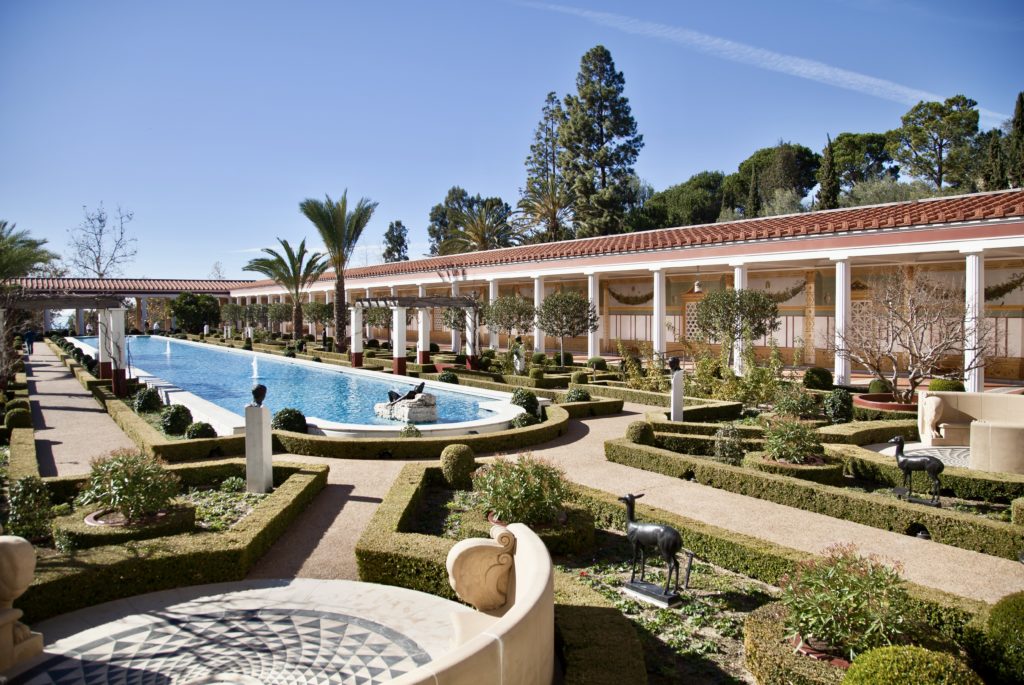
It seems a half mad idea to recreate an ancient villa to house your art. But Getty, with his obsession for antiquity and a Caesarian attitude, must have enjoyed the challenge of creating something so unique.
In this Getty Villa guide, you’ll find a history and overview of the collection, a list of must see masterpieces, and tips for visiting.
History Of The Getty Villa
J. Paul Getty was an American billionaire, oil tycoon, and art enthusiast. He came from money and power.
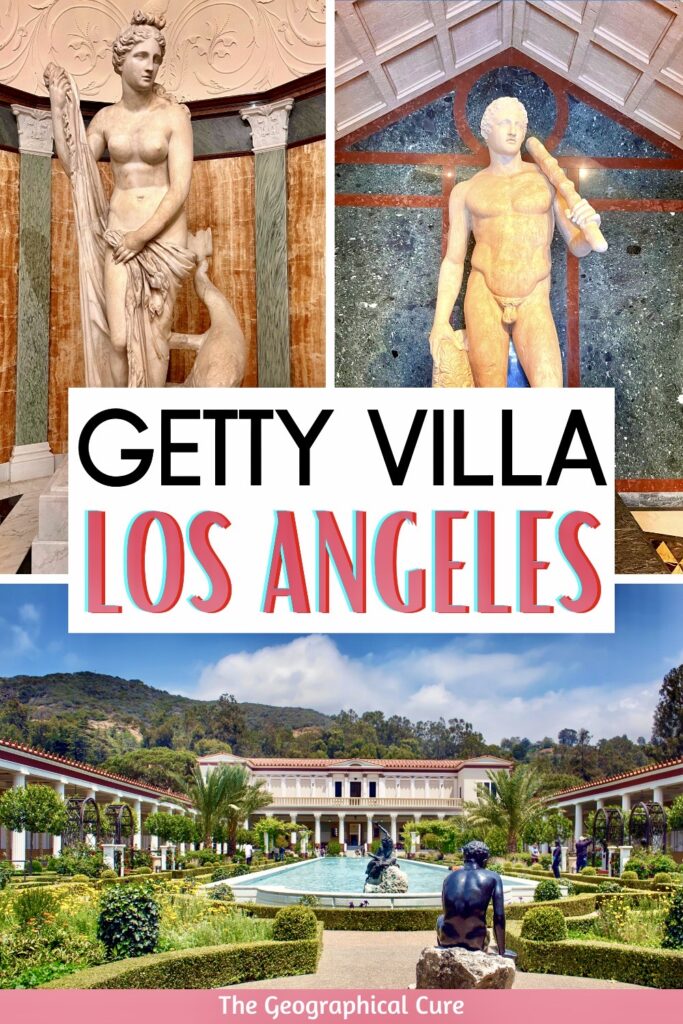
With a loan from his father, he invested in oil wells in the Middle East and became “the richest man in the history of the world.”
But Getty didn’t just have oil fever. He started seriously collecting art in the 1930s.
He was a passionate and lifelong collector who though collecting art was “one of the most exhilarating and satisfying of all human endeavors.”
Getty traveled widely throughout his life and made a habit of visiting archaeological sites. Trips to Italy left him with a taste for bronze and marble sculptures from ancient Greece and Rome.
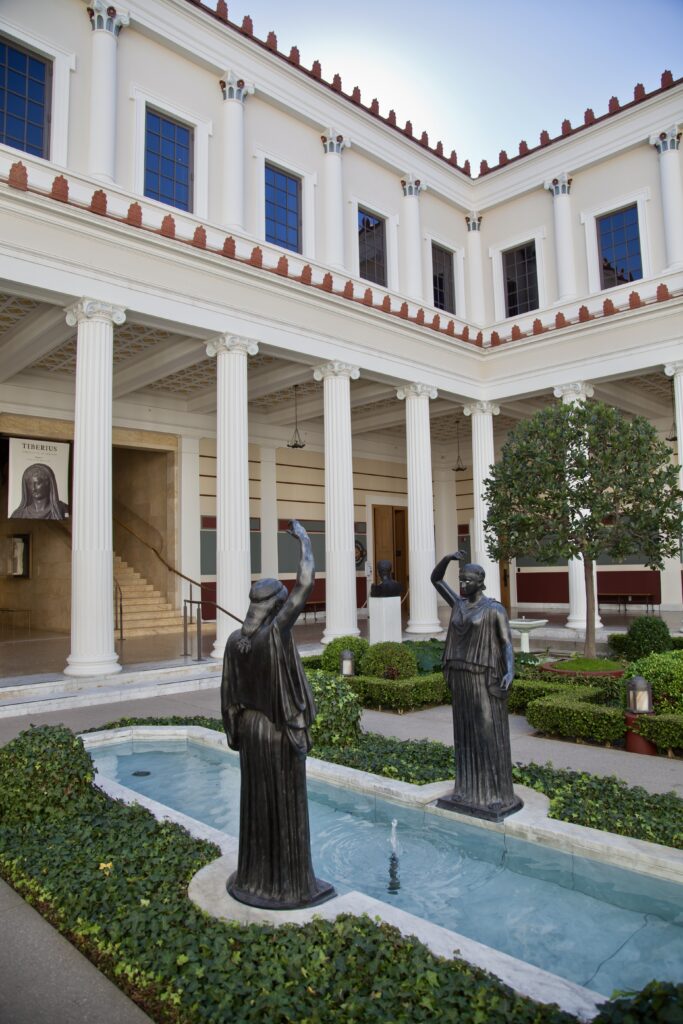
But Getty didn’t want to just admire them in private.
He wanted to share his art with the world and let others travel back in time. By doing so, he hoped to “further the diffusion of artistic and general knowledge.”
In the early 1970s, Getty set about building a museum to house his collection on his 64 acre Malibu ranch. He modeled it on a luxury Roman villa from 40 B.C., the Villa dei Papiri excavated near Herculaneum and Pompeii.
READ: Ultimate Guide To Pompeii
The villa was owned by the wealthy Roman consul Lucius Calpurnius Piso Caesonius. He was the father-in-law of Julius Caesar, a Roman whom Getty greatly admired.
The villa’s inhabitants lived surrounded by sculpture. It was a way to demonstrate their wealth and culture and earn an air of prestige.
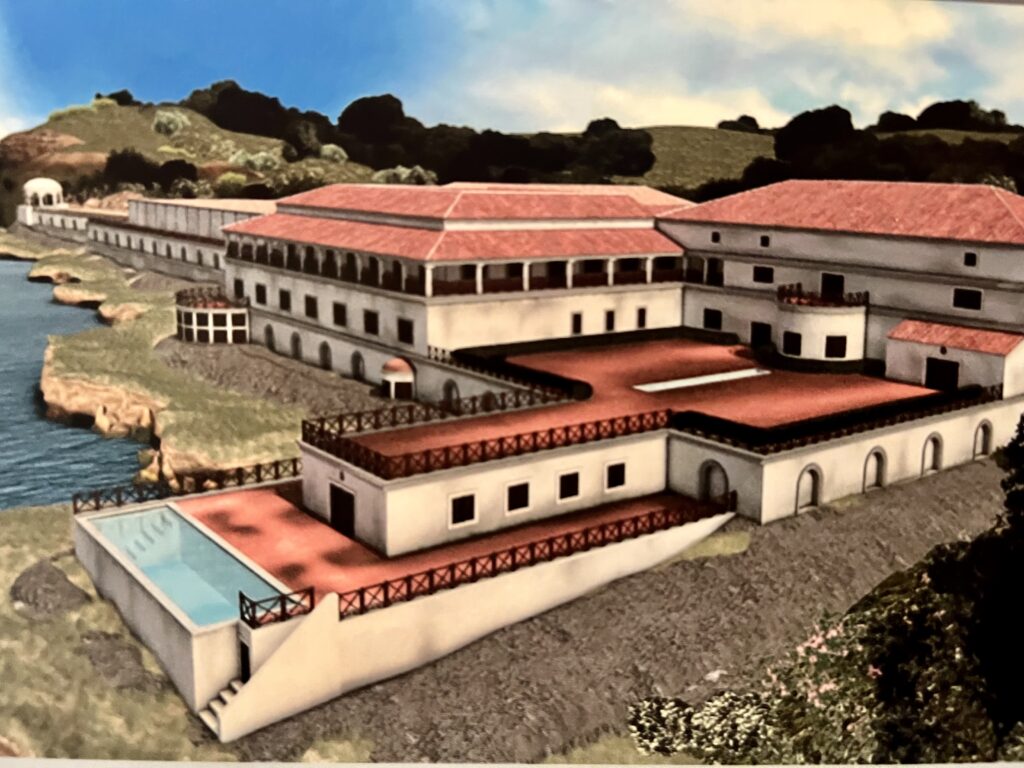
In 79 A.D., the eruption of Mt. Vesuvius destroyed the villa and it was only re-discovered in 1750. Archaeologists uncovered underground tunnels, sculptures, frescos, stone pavements, and other artifacts.
In particular, 1,100 charred papyrus scrolls were discovered in the villa’s library, giving the villa its nickname the “Villa of Paper.”
The scrolls including the writings of Philodemos of Gadara, a philospher who was the patron of Caesonius. This links the villa to Caesonius.
Modern excavations of the villa have uncovered frescos on walls and geometric patterned mosaic and terrazzo floors. But the vast majority of it remains buried.
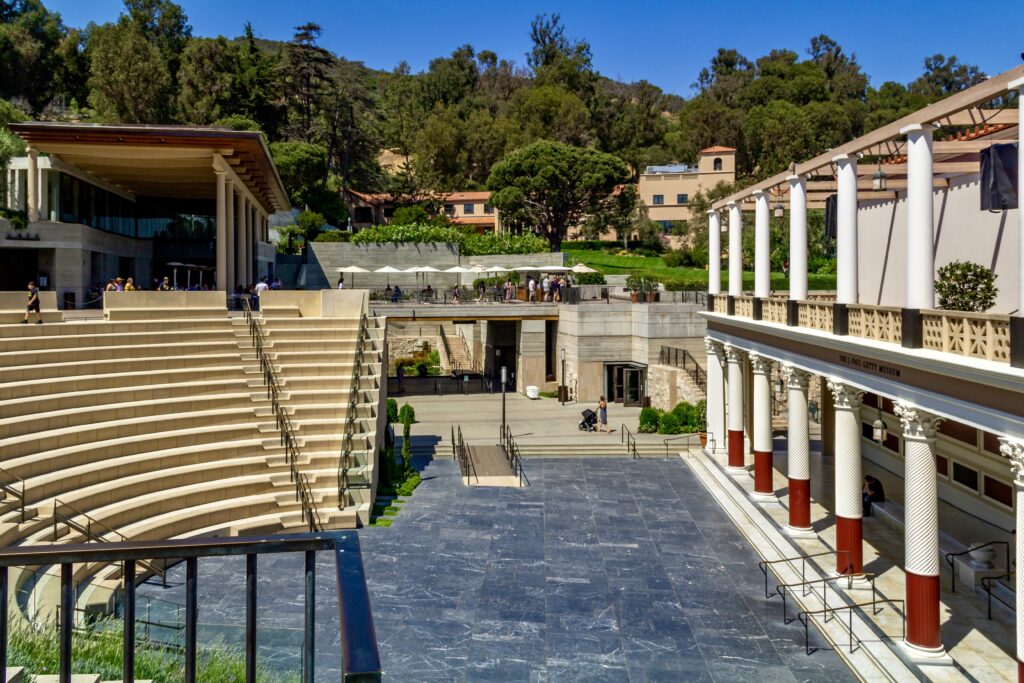
The team that Getty hired to recreate the ancient villa included architects, artisans, and archaeologists.
Getty reimagined the villa as an archeological site. Walls and a concrete courtyard below the villa create the sense of looking down into the dig pit.
Much of the Villa dei Papiri remains un-excavated and its elevations are mostly still a mystery. Therefore, architects based many of the Getty Villa’s architectural and landscaping details on other ancient Roman houses in the towns of Pompeii, Herculaneum, and Stabiae.
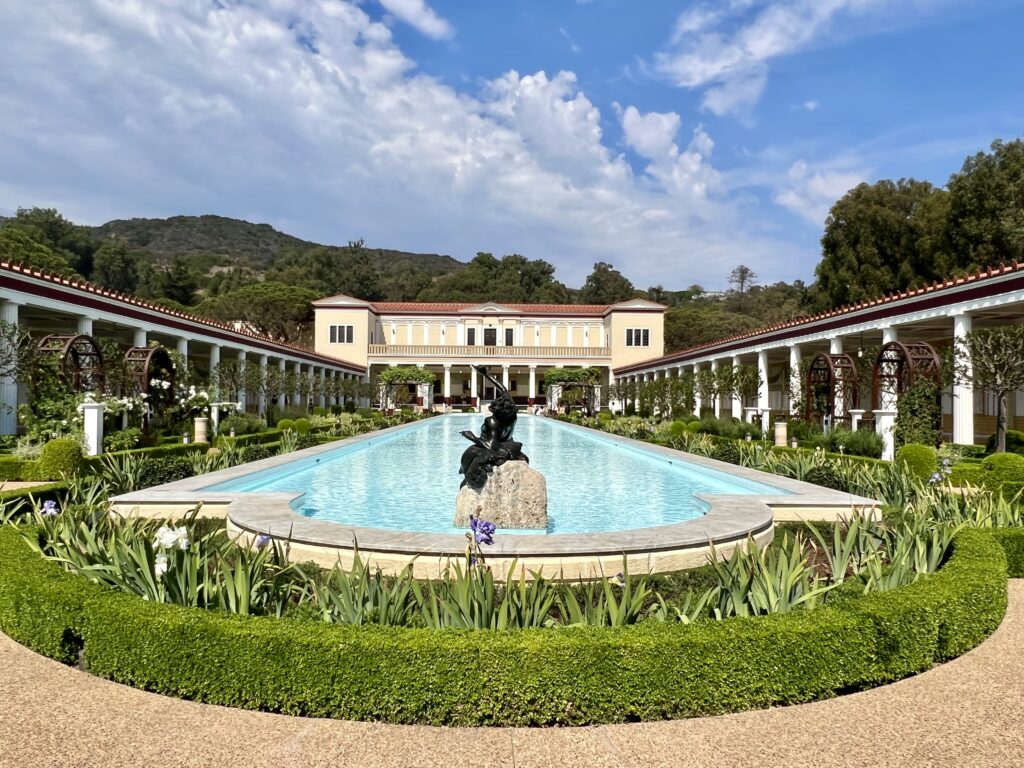
After a 9 year $275 million renovation, the Getty Villa opened to the public in 2006, becoming the home of the Getty Center’s Antiquities Collection. In 2015-18, further renovations were completed. The result is simply stunning.
Getty famously said: “Go to Pompeii and Herculaneum and see Roman villas the way they are now [in ruins] — then go to Malibu and see the way they were in ancient times.”
The Getty Villa can draw mixed reactions. Some art critics deride it for blurring the line between actual antiquities and a faux reproduced villa-environment.
This seems a silly criticism to me, as the difference between the two is readily apparent. The “atmosphere” of being in a reimagined Roman villa doesn’t detract from the academic quality of the art in any way. If anything, it enlivens the experience, just as Getty intended.
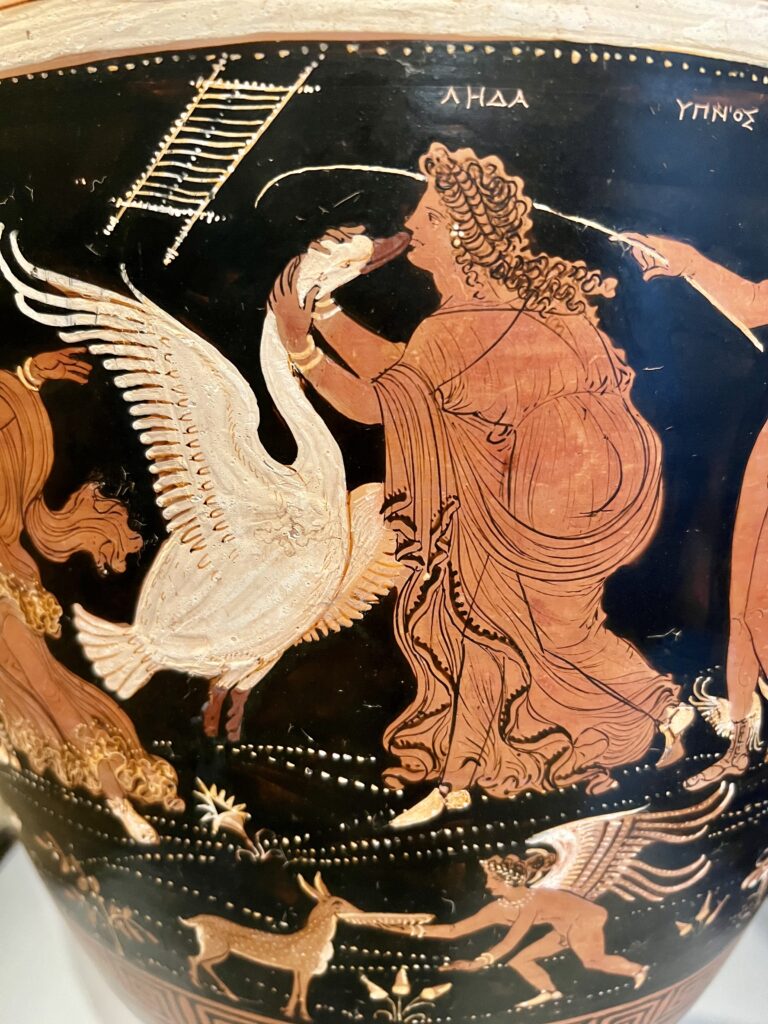
Overview Of The Getty Villa
The Getty Center is an immersive experience. It’s as much about architecture as art. Even if the museum didn’t have any art, it would be worth the price of admission just to see the reimagined Roman villa.
But the art is spectacular. You’ll almost feel like you’re in Rome or Pompeii.
There are 33 galleries on two levels that are organized thematically. 5 galleries are dedicated to temporary exhibits.
There are 1,000 antiquities on display, including sculpture, busts, pottery, paintings, jewelry, mosaics, and frescos. If you’re a history buff, you could spend hours perusing these galleries.
The first floor showcases the Greek, Etruscan, and Persian collections. In addition, there’s an area explaining Getty’s love for collecting artifacts from antiquity as well as his life and legacy. The second floor is exclusively dedicated to Roman art.
You can check out this online map to get oriented before your visit.
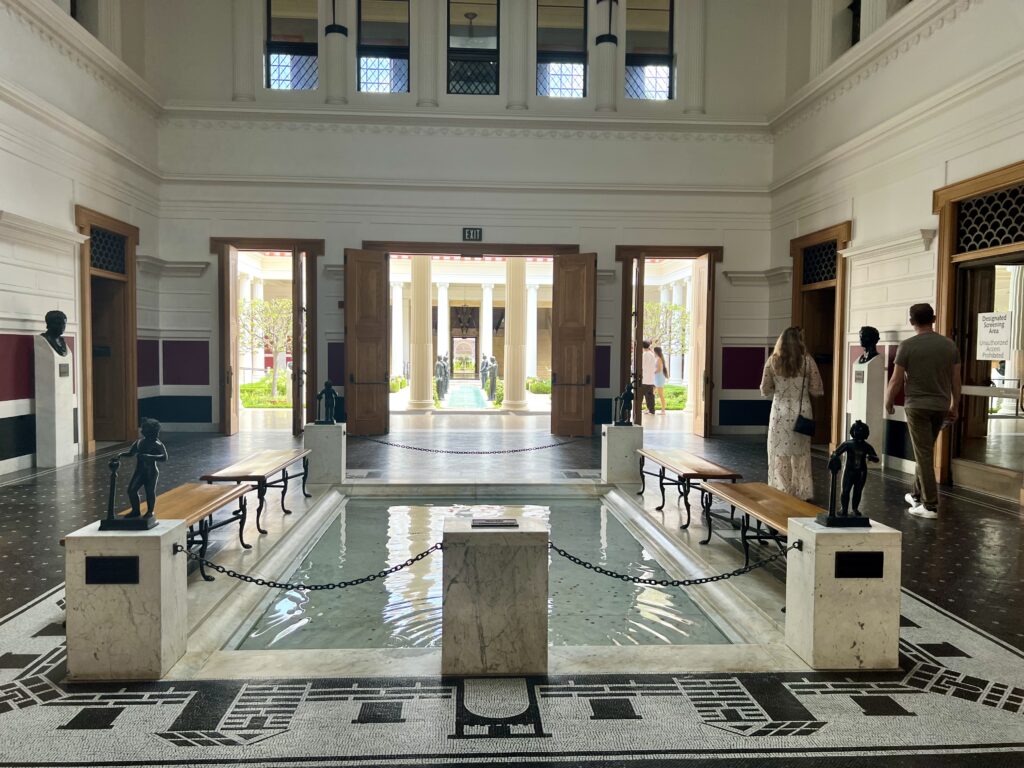
Guide To The Getty Villa: What To See
Here are 15+ of the top masterpieces and spaces you’ll see on a tour of the Getty Villa, in roughly the order you’ll encounter them on a visit.
1. Atrium
You first enter into the atrium through a colonnaded facade and a floor paved in white marble.
Entry squares like this were common in the 2nd century B.C. They were the heart of a Roman house and designed for strolling and conversation.
Ionic half columns support a coffered ceiling with an open skylight, set over a square pool. The skylight has a coral frieze with lion’s head drain spouts. The geometric floor is copied from the House of the Faun in Pompeii.
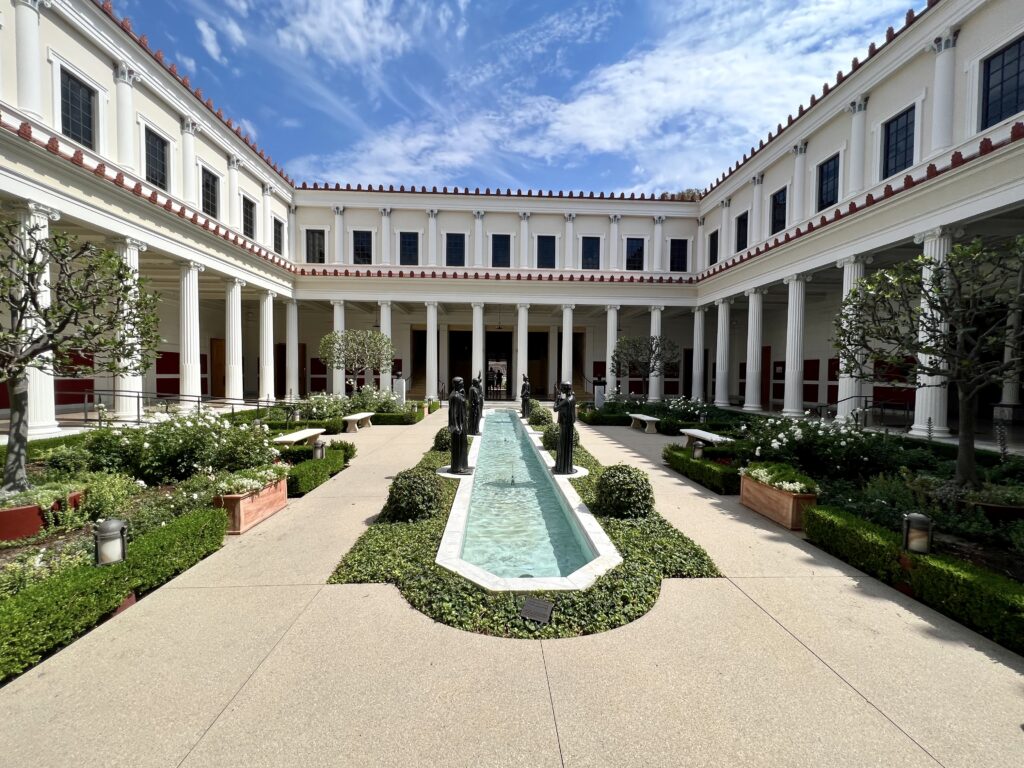
2. Inner Peristyle
The inner peristyle is a pleasing and intimate green space, and was also common in villas from the 2nd century B.C. Inspired by the House of the Silver Wedding in Pompeii, the space is defined by 36 Ionic columns surrounding a garden. At each corner is a white marble fountain.
The colonnade is surrounded by walls decorated in the First Pompeian Style. The columns were modeled after the House of Colored Capitals in Pompeii. The ceiling was imitates the Street of Tombs in Pompeii
The peristyle is home to some of the Chiurazzi Bronzes. The originals are in the Archeological Museum of Naples and reproductions are on display at the villa.
The bronze statues are of mythological women who seem to be drawing water from a stream. They’re set in marble bases around the pool.
Legend holds that the King of Argos ordered his 50 daughters to kill their Egyptian husbands on their wedding night. One daughter defied her father’s mandate. Her grateful father-in-law exempted her from her sisters’ agonizing fate — eternal water haulage.
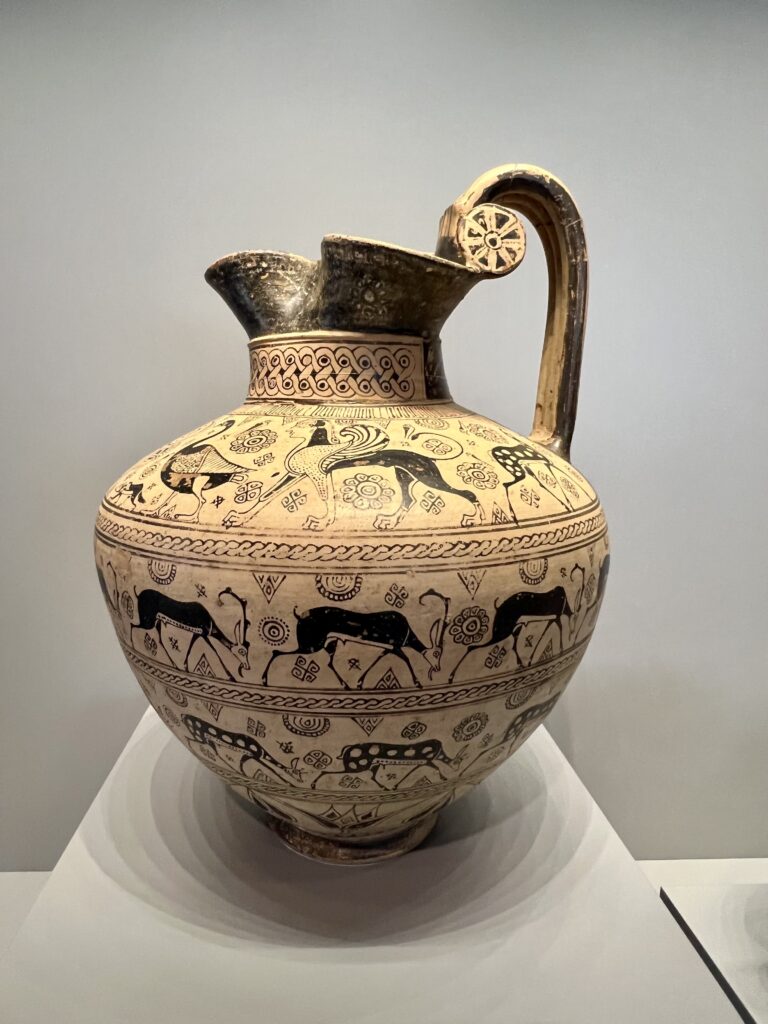
3. Athenian Vases
The Getty Villa houses a large collection of Athenian vases, which in ancient times were used for drinking, serving, and storage.
They were initially made with fired clay and the “black figure technique.” That technique depicted figures in glossy black, with finely incised details. Sometimes red and white colors were added.
By 500 B.C., new techniques had developed. Artisans used red figures, gilding, and further refinements of shape.
They decorated the vases with deeds of the gods and heroes, scenes from domestic life, or sporting events like chariot races. Artists signed some of the vases, so we know their identities.
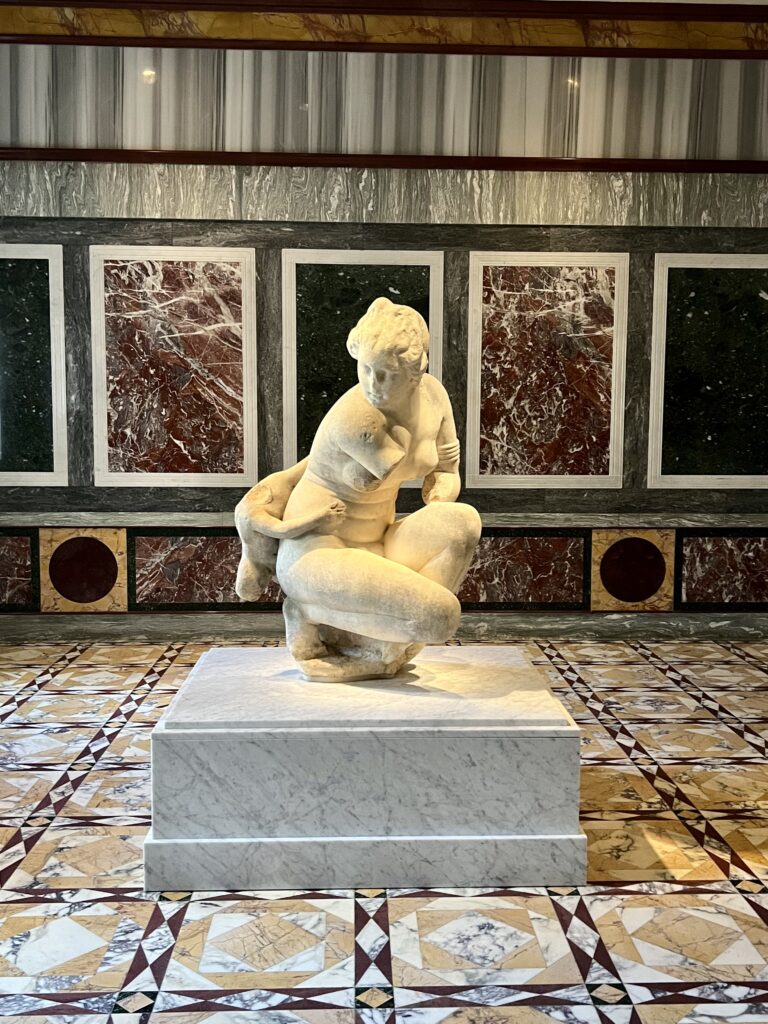
4. Hall of Colored Marbles & Crouching Venus
This “status symbol” gallery is a luxurious space. The hall gets its name from the 14 different varieties of marble used.
It showcases the types of marble that would have adorned the houses of wealthy Romans in antiquity. Marble was used for floors, walls, and fountains.
The marbles in this room were inspired by homes in Pompeii and Herculaneum. The hall’s floor is cut from ancient salvaged pieces.
In the center of the room is the Crouching Venus sculpture. It’s the first major sculpture you’ll see at the villa and one of Getty’s earliest acquisitions. It’s a larger-than-life-size statue of the goddess, kneeling down to bathe with her son Cupid.
In the 18th century, a well known restorer added arms to Venus and arms and legs to Cupid. These were all removed before Getty bought the statue.
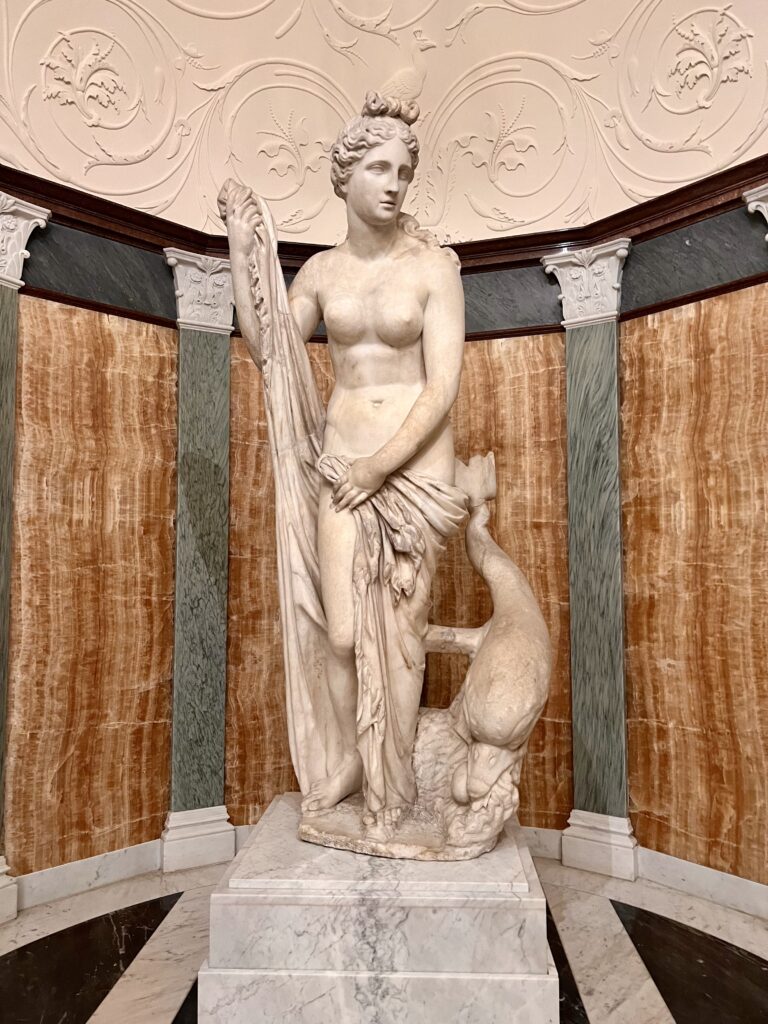
5. Basilica & Venus Statue
Right next door is the Basilica, another gorgeous room clad in marble. In ancient Rome, a “basilica” was a large public hall. But sometimes they were added to private homes and used as shrines.
The basilica is lined with 8 white marble Corinthian columns, topped with elaborate multi-colored capitals. It has a vaulted and coffered ceiling, with stucco work derived from Pompeii.
The intricate marble floors were made with ancient stone fragments in a design copied from the ancient Villa dei Papiri. Statues stand in bays in front of recessed honey colored onyx windows on the side walls.
Under a half dome in the apse is a marble statue of Venus with some modern restorations. It’s a variant of the famous Venus de Milo sculpture in the Louvre. Venus is accompanied by a dolphin, alluding to her birth from the sea.
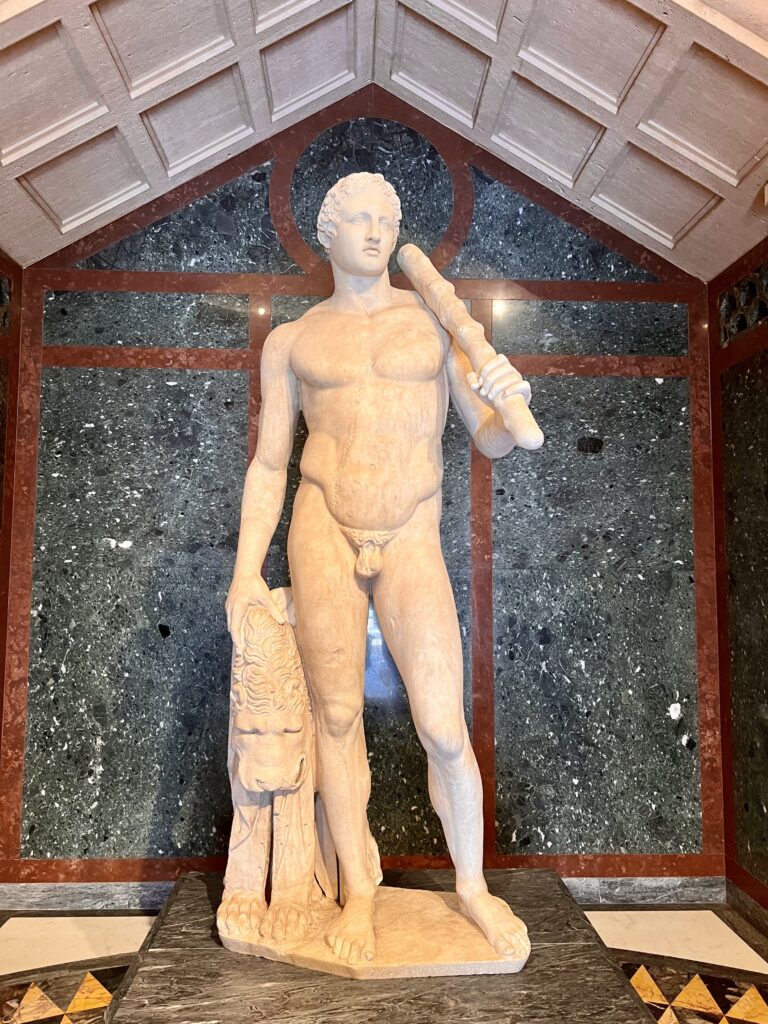
6. Temple Of Hercules & Landsdowne Hercules
The Temple of Hercules is another glittering marble room. The elaborate marble floor is a work of art itself, composed of 4 million pieces of stone.
It reproduces a 1st century pavement from the Villa dei Papiri. Yellow and gray triangles form a geometric pattern of 22 concentric circles.
In the center is an illusionistic polychrome marble circle. The original circle was one of the first things to be excavated at the ancient villa, marking the official discovery of the Villa dei Papiri. The original is in the National Museum of Naples.
The centerpiece of the room is the famous Landsdowne Hercules. It’s one of the Getty’s prize possessions and the piece that inspired Getty to recreate the Villa dei Papri. He purchased it in 1951 from the Marquess of Landsdowne.
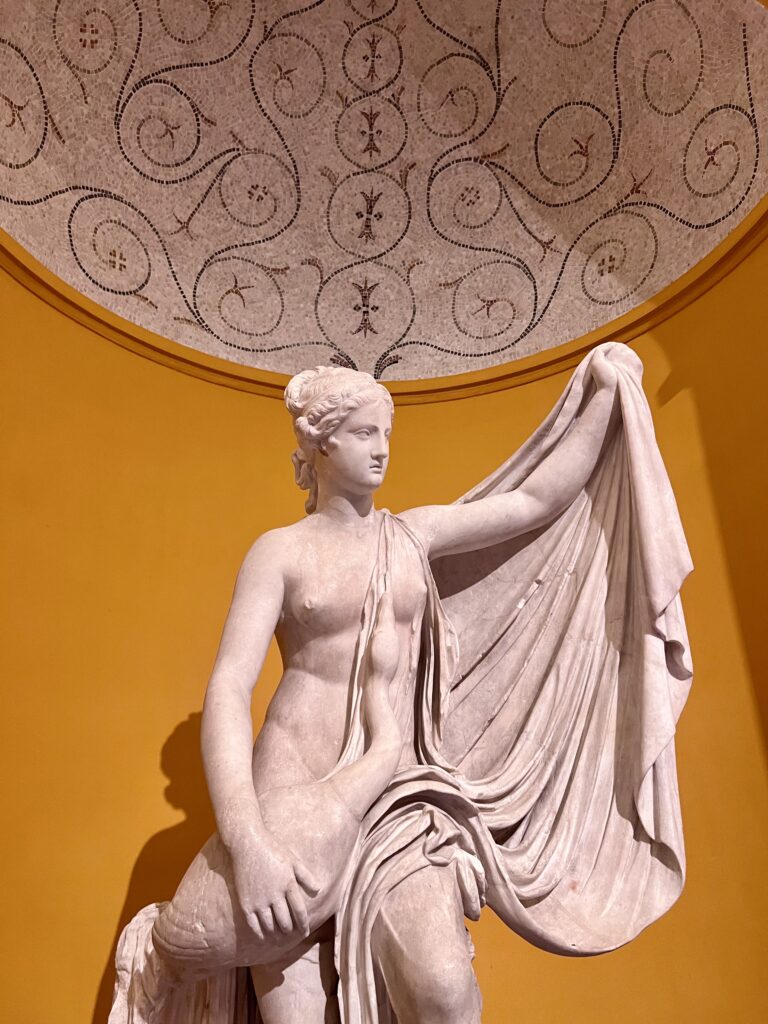
The statue stands in a niche in front of green marble and red porphyry. This kind of room wouldn’t have existed in a typical Roman villa. It was created specifically to house the statue.
The Landsdowne Hercules was discovered in 1790 near Hadrian’s Villa in Tivoli. Getty acquired it in 1951. Hercules looks buff and carries his trademark club and lion skin.
In this room, you’ll also find a Portrait Head of Tiberius and a statue of Leda and the Swan. Leda was acquired at the same time as the Hercules.
Getty purchased Tiberius, also known as the Landsdowne Tiberius, in 1971. For over a century, the head was attached to the wrong body. It depicts Tiberius with his recognizable thin lips and eyebrows.
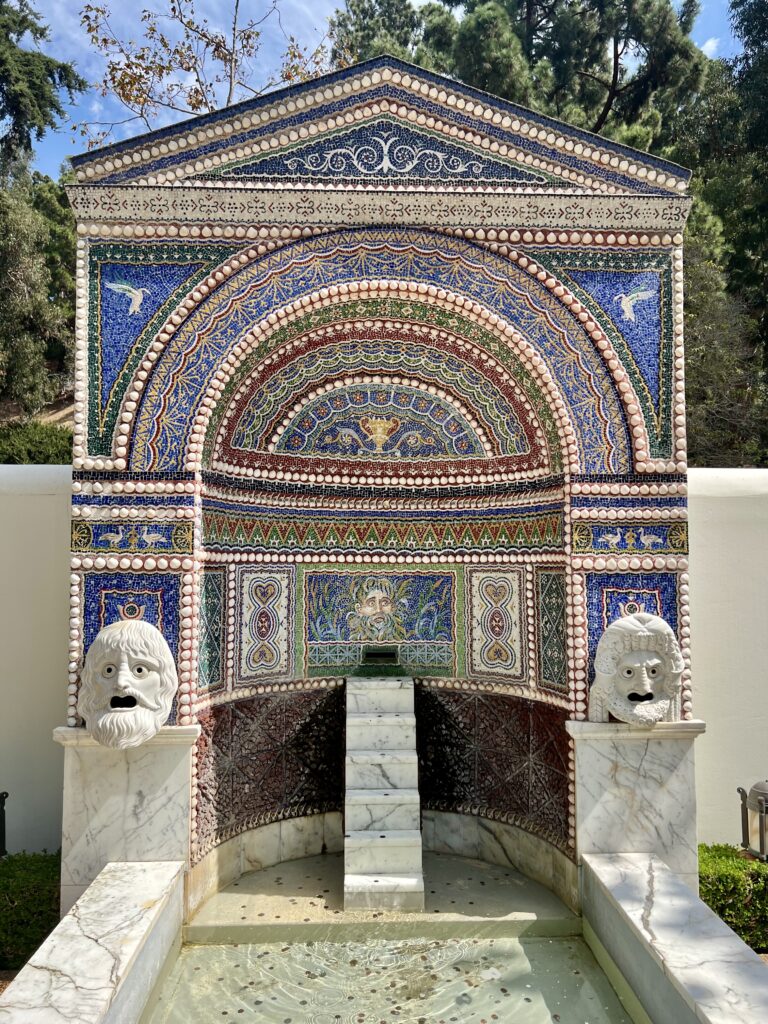
7. East Garden
Two bronze doors then lead to the East Garden, which is planted with mulberry trees, laurels, boxwood, ivy, and ferns. It’s one of the quietest and most tranquil spaces in the villa.
A fountain in the center was copied from the Villa dei Papiri. Water cascades from life size bronze animal heads, include civets.
The spectacular fountain on the wall is an exact copy of the Great Fountain of Pompeii. It’s made of colorful mosaics and shells and adorned with theater masks.
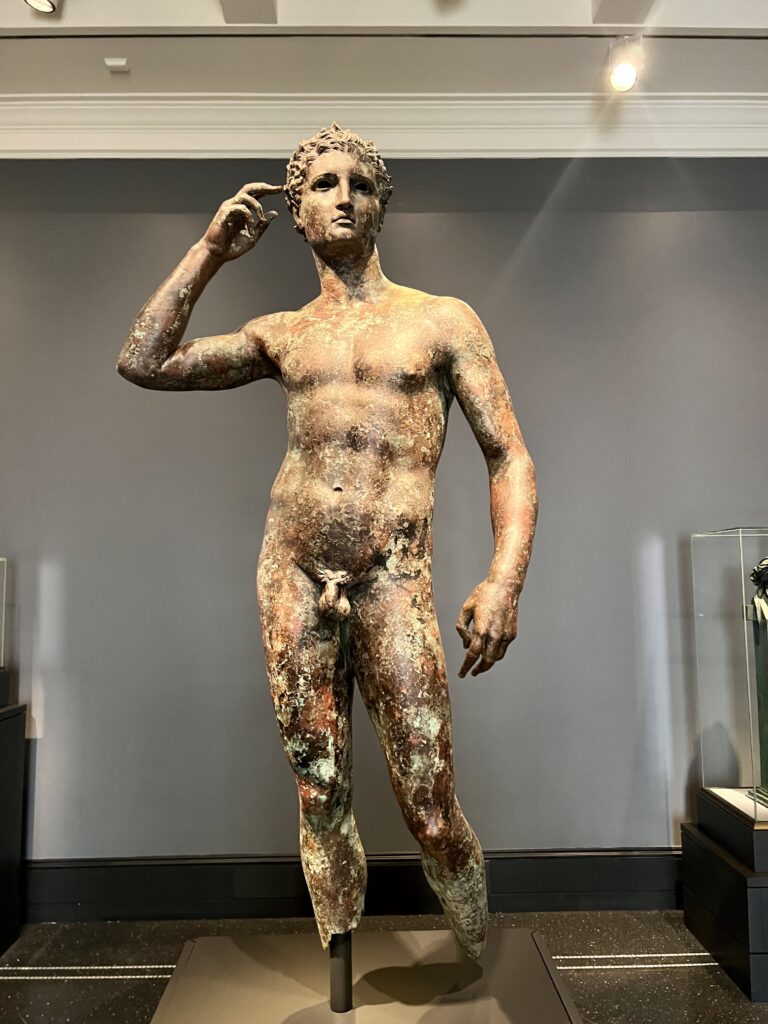
8. Getty Bronze
The 2,000 year old Getty Bronze is the most priceless and famous piece in the Getty Villa collection. It’s also known as the Statue of a Victorious Youth. The sculpture may remind you of Michelangelo’s David in Florence’s Accademia Gallery.
Kept in a climate controlled room, it’s a high caliber bronze Greek statue of a handsome male athlete with good hair. He’s about to remove his wreath and dedicate it to the gods.
Ancient bronze sculptures from Greece are exceedingly rare. Only a handful survive today.
Bronze is an extremely precious and expensive material. Most often, the bronze was melted down for metal.
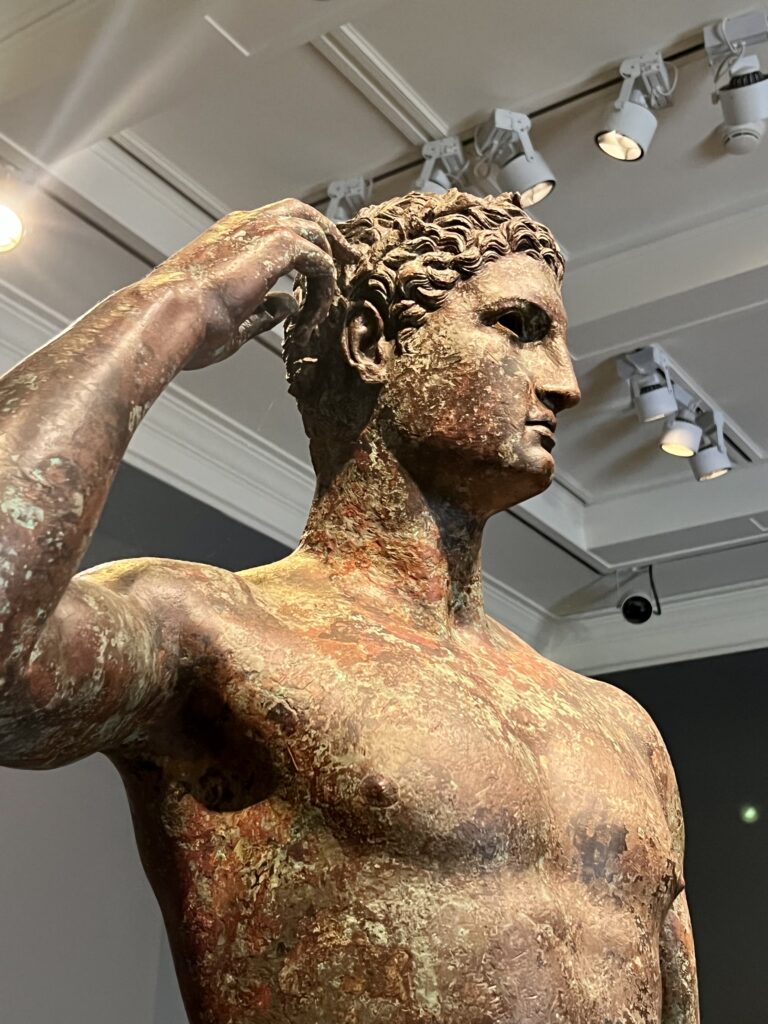
The statue was preserved by a cosmic accident. It was submerged and preserved in a shipwreck in the Adriatic Sea, and only discovered in the early 1960s. As a result, the body, once golden, is now a mottled green and brown.
Italy has asked for the return of the sculpture. But the Getty maintains that the statue was bought in good faith (for $4 million), after it had been retrieved in international waters. And, in fact, they have an extemely good case against forfeiting the rare statue.
In the same room, you’ll also see the Head of a Man from 150 B.C. The bust is of exceptional quality and very expressive, indicating that he was an important man.
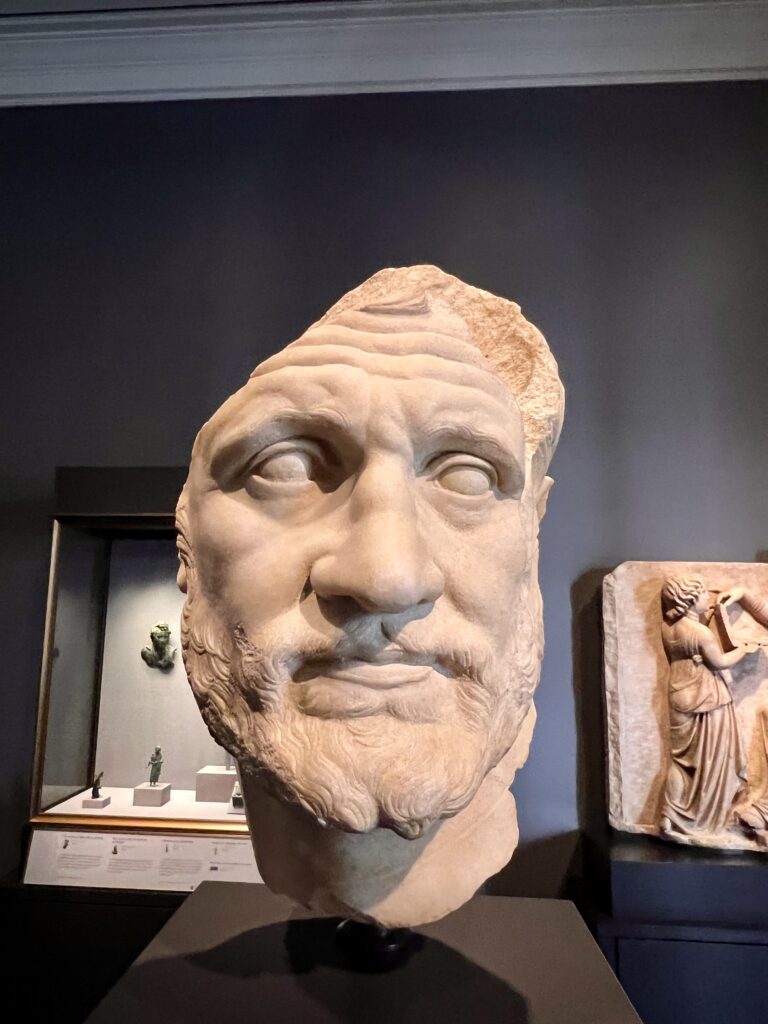
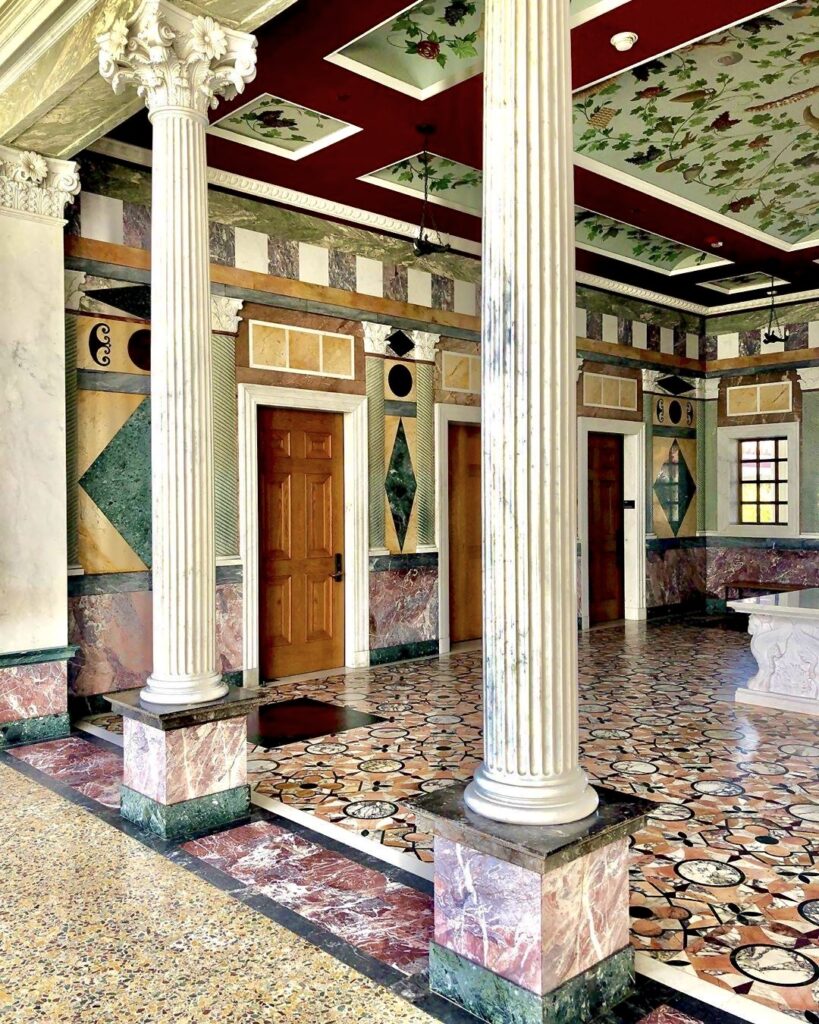
9. Tablinum
A tablinum was an important room in a Roman household. It was the main reception room where the host entertained guests. It stands between the inner and outer peristyles.
The tablinum is ornate and richly decorated, with colorful marble inlaid in geometric patterns on the floors and walls. Dating from late 1st century, the designs are replicated from different villas in Herculaneum.
The ceiling has recessed arched panels. There’s an illusionistic vine motif, which incorporates floors, birds, cupids, and fruit. The floral elements were intended to “link” the inner and outer gardens.
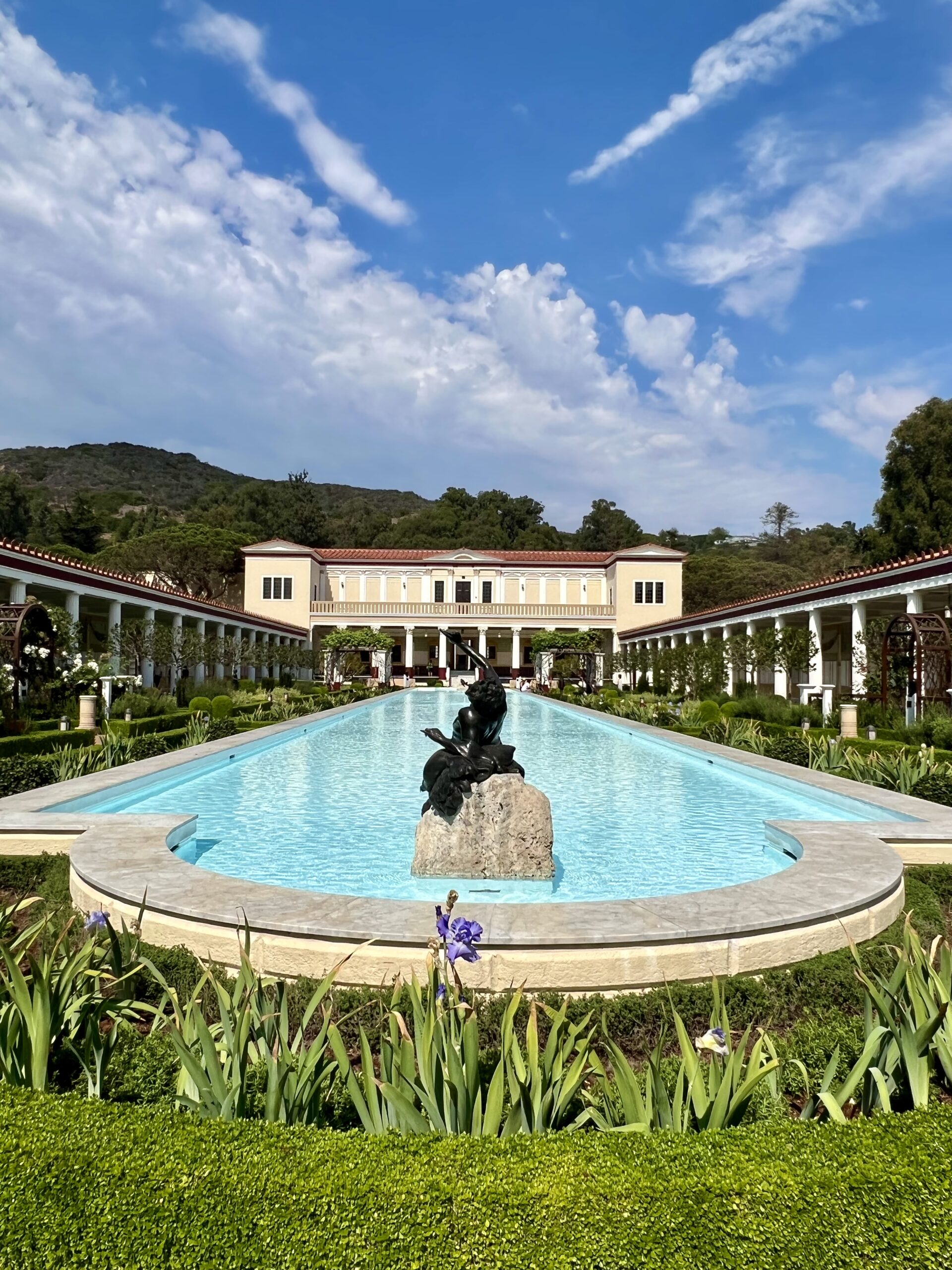
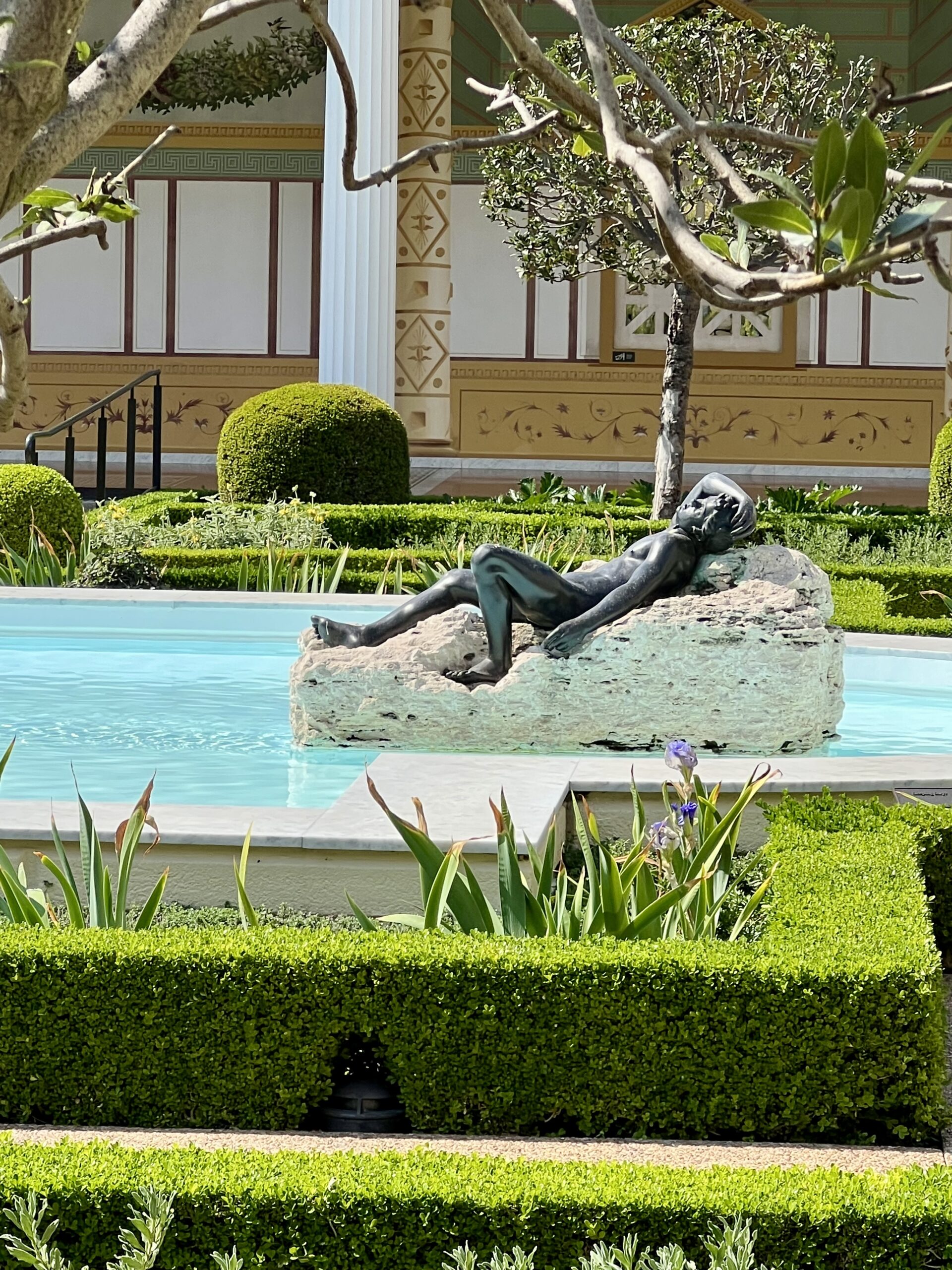
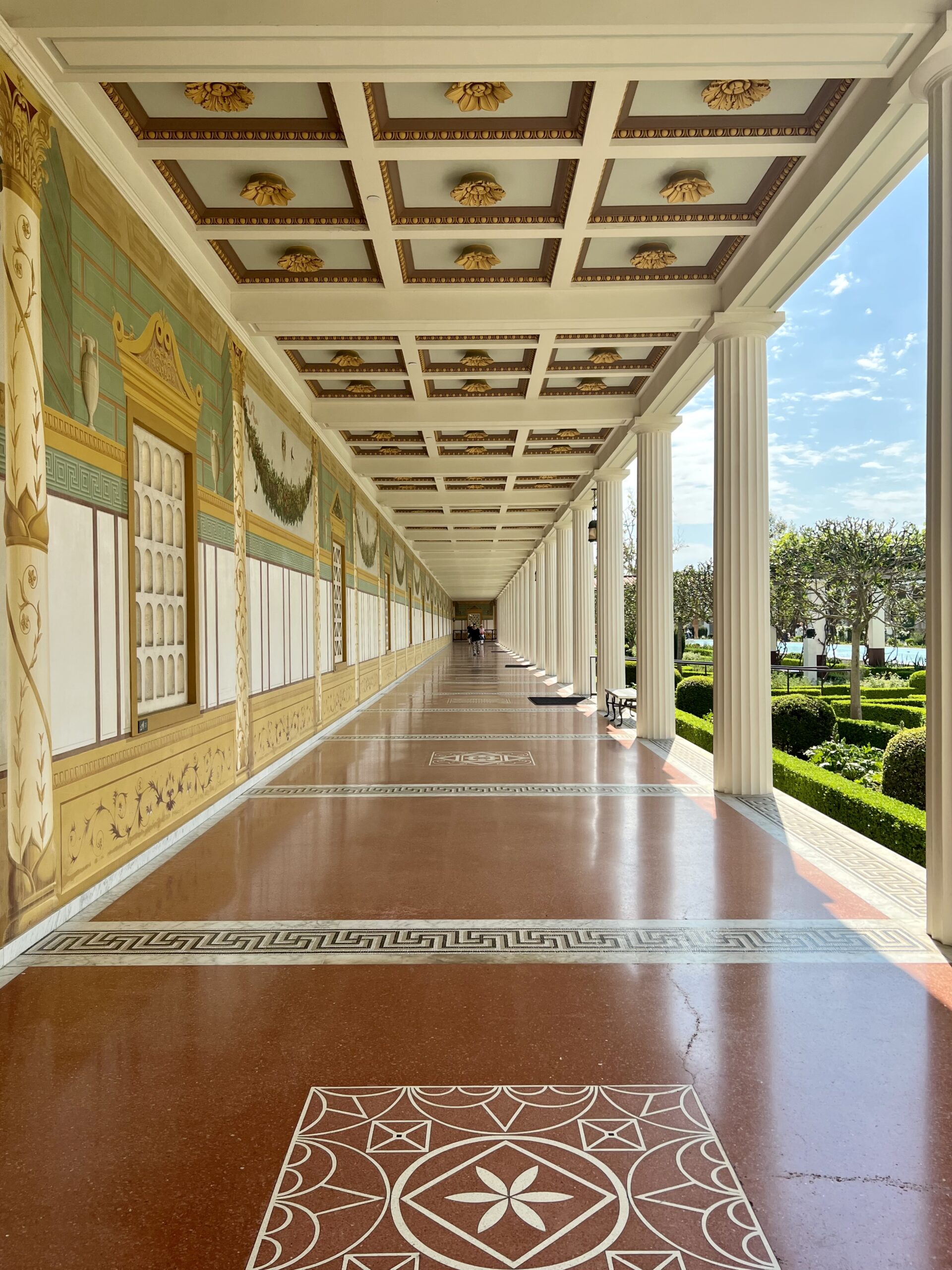
10. Outer Peristyle
Two bronze doors open from the Tablinum onto the Outer Peristyle. This is the heart of the Getty Villa and its largest garden space.
It has a central reflecting pool running its length, 1,000 Mediterranean plants, sculptures, and sybaritic bronze statues. It’s framed on each side by porticos, with columns copied from the basilica at Pompeii.
You can walk in the arcaded pathways. They are decorated with tromp l’oeil frescos in the Second Pompeian Style and blood red porphyry marble floors.
The north wall features frescos of landscapes and architecture copied from the Villa dei Papiri and another villa in Oplontis. Frescoes with theatrical masks on garlands are copies of those from the Villa of Publius Fannius Synistor.
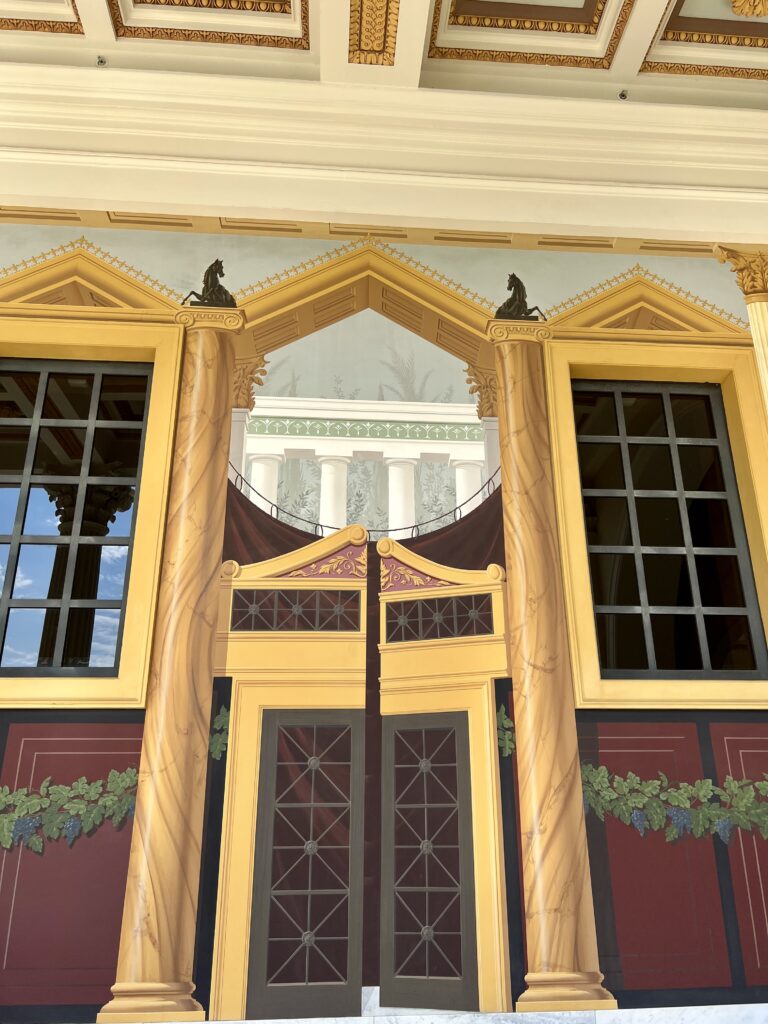
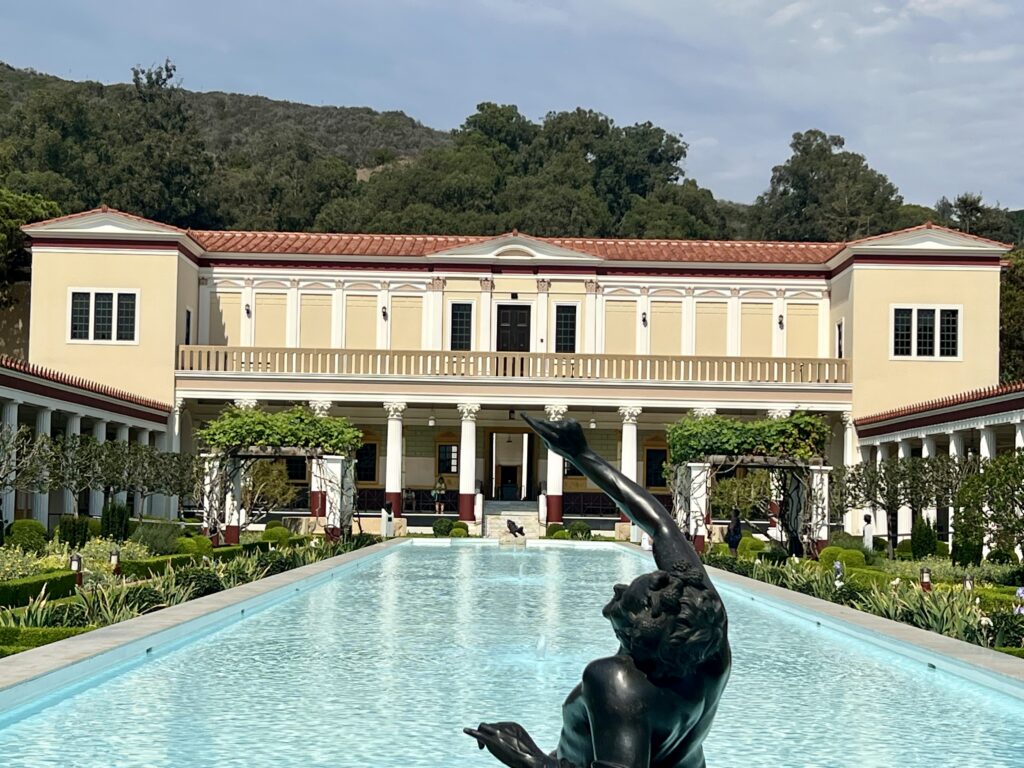
There are two square arbors covered with grape vines. There are myriad plantings, but I loved the pomegranate trees best.
In and around the pool are copies of bronze statues, including half-man half- goat satyrs. You’ll also find semicircular benches to rest, copied from ones in Pompeii.
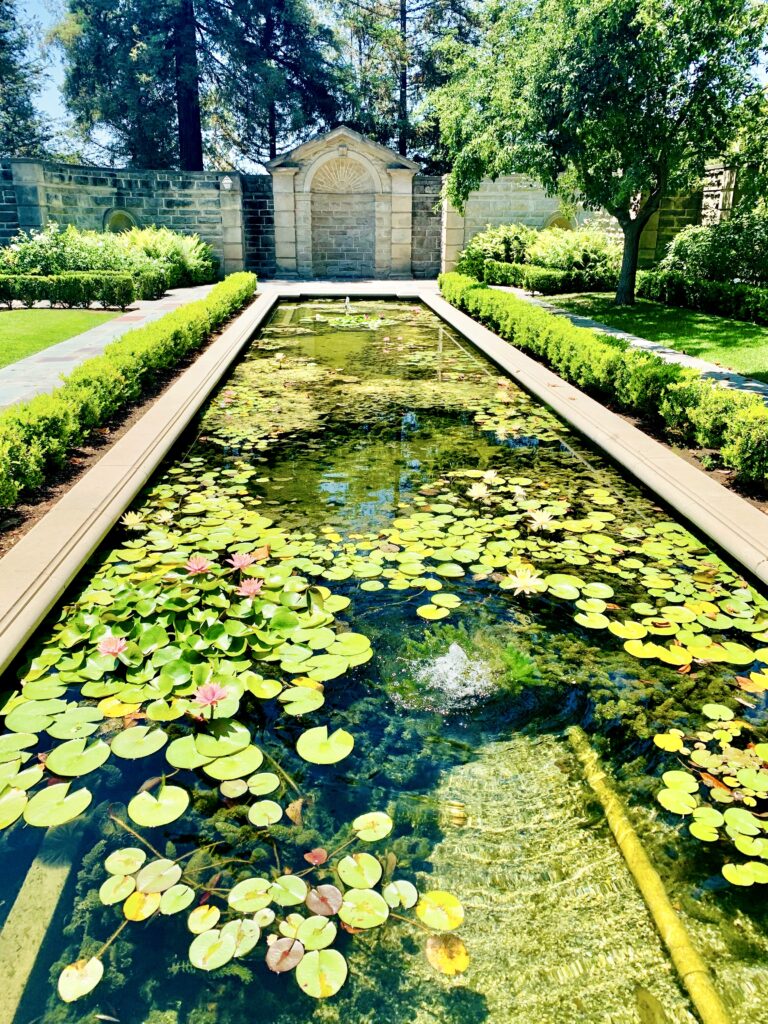
11. Herb Garden
Immediately to the west of the outer peristyle is the Herb Garden. Like nearly everything at the villa, the garden was based on the original herb garden at the Villa dei Papiri. It’s often missed by visitors because it can’t be seen from many villa locations.
Most wealthy Romans had herb gardens, which were used for medicinal and culinary purposes. You can inhale the sweet ascent of lavender, mint, basil, and thyme. You’ll also see a lovely lily pond, with a whimsical waterspout depicting Silenos, a friend of Dionysis.
12. Funerary Relief of Hadirat Kathina
Acquired by the Getty Villa in 2019, this is a limestone funeral relief renowned for its intricate carving. Dating from around 200 A.D., it depicts a bejeweled woman with an Eastern headdress.
It was once adorned with golden paint. You can still see flicks of its original colors, though time has stripped much away.
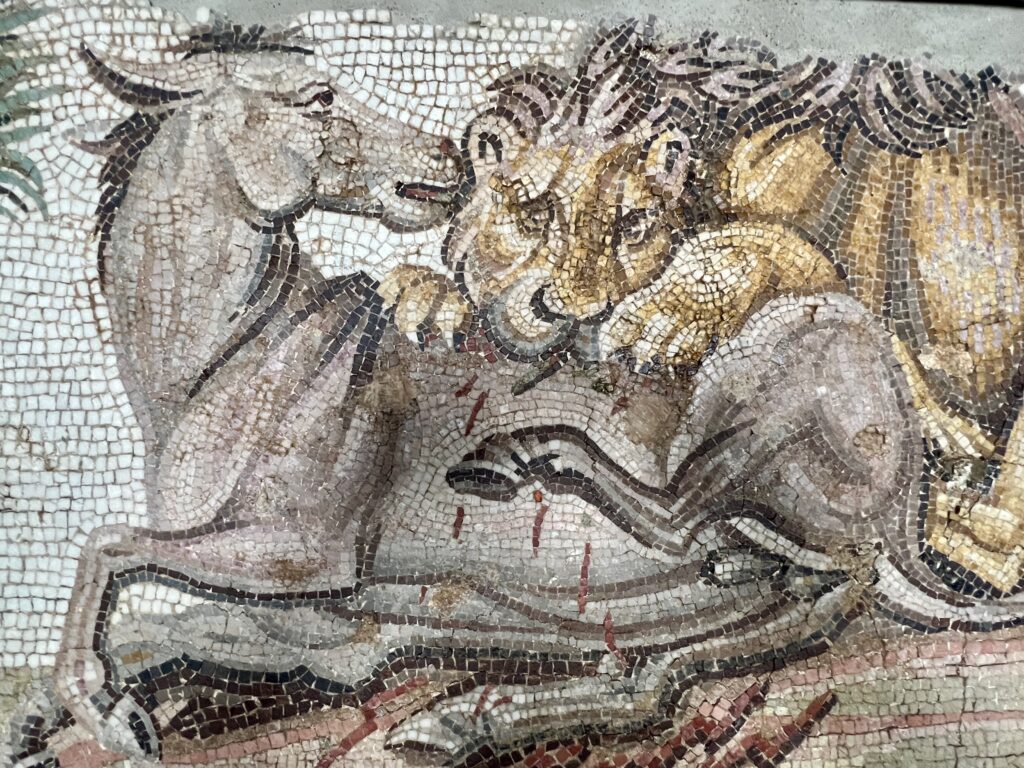
13. Roman Floor Mosaics
On the second floor, you’ll see walls mounted with large Roman mosaics. Mosaics were popularized in the late 2nd century B.C.
Elaborate mosaics were used to decorate luxurious domestic and public buildings across the broad expanse of the Roman Empire. The mosaics transformed entire rooms into spectacular settings of vibrant color, figural imagery, and abstract design.
The floor mosaics often depicted violent and combative scenes of hunting and savagery. For example, in the mosaic above, a lion viciously chomps on the back of a wild ass.
On a calmer note, you’ll also see a lovely mosaic of a peacock with a long multi-colored tail. Peacocks had special significance and were associated with immortality.
READ: Guide To Sicily’s Villa Romana del Casale
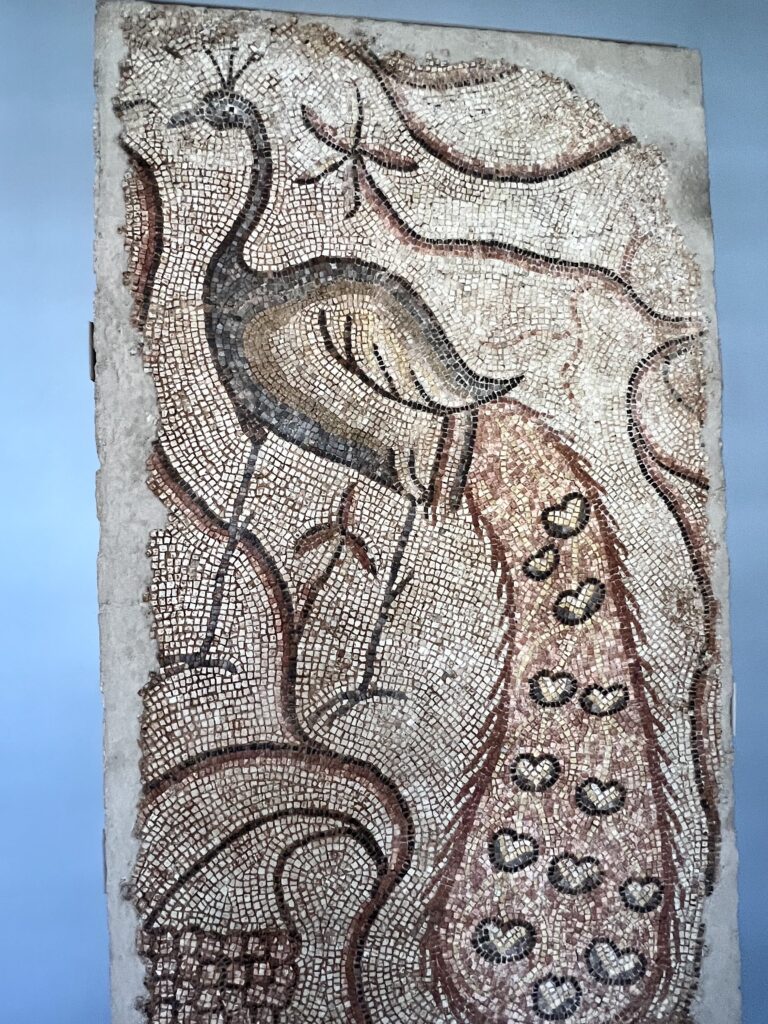
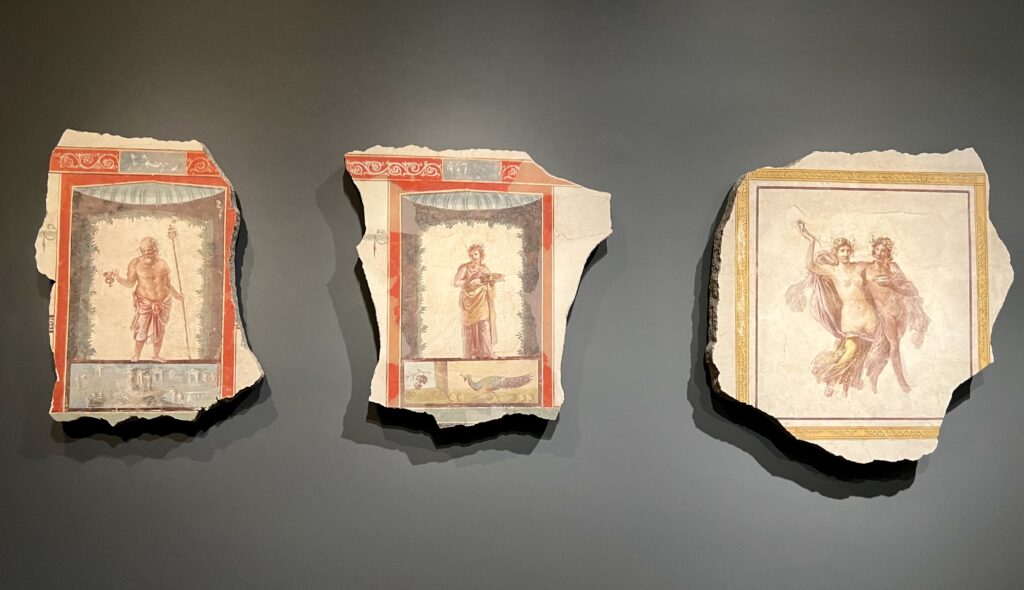
14. Boscoreale Frescos
In another room, you can admire frescos from the black and white rooms of the Villa of Numerous Popidius Florus at Boscoreale. The villa dates from the early 1st century B.C. and was excavated in 1905-06.
In contrast to the fancy seaside villas of Pompeii, Boscoreale was a working farm. Despite being more modest, the country residence had some of the finest wall paintings of that era.
Indeed, the frescoes are among the most important to be found anywhere in the Roman world. They identify the original owner as a rich man with exquisite taste.
The frescos exemplify the late Second Pompeian Style, the most renowned style in Roman wall painting. They depict illusionistic vistas, fanciful architectural elements, and scenes from daily life — all set against red, yellow, white, and black bands of color.
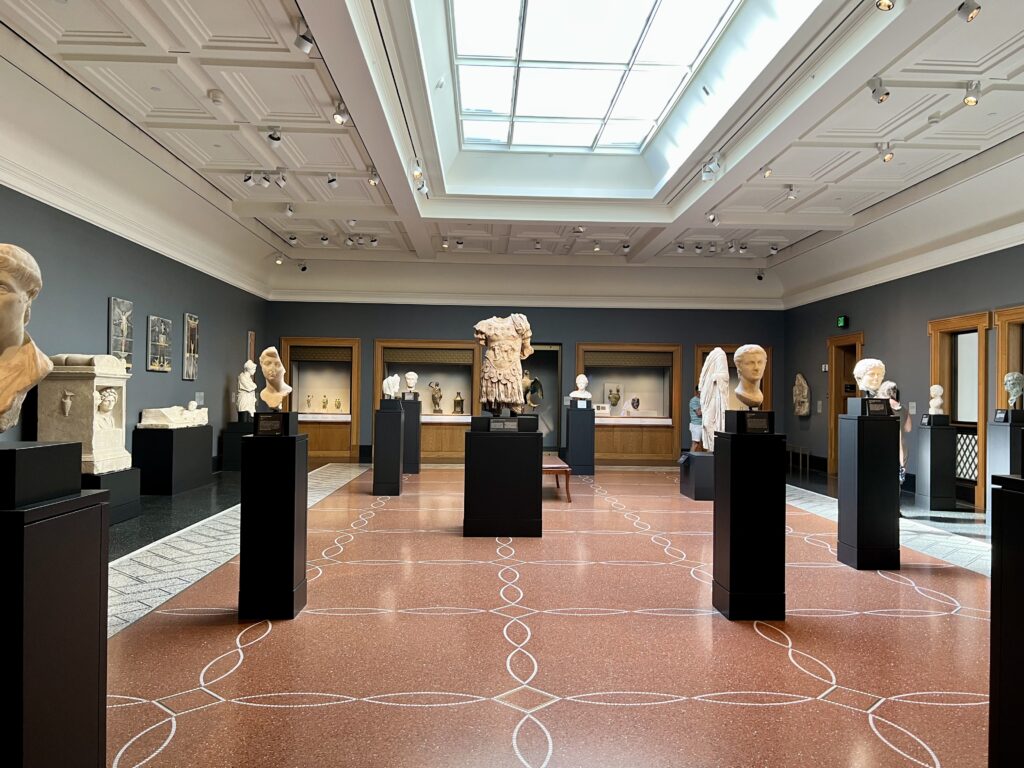
15. Galleries Of Early And Late Roman Sculpture
This Gallery of Early Roman Sculpture room features statues and busts from early Roman sculpture, including busts of the emperors. The greatest innovation over Greek sculpture was in portraiture.
Unlike the Greeks, Romans adopted a highly naturalistic style that didn’t idealize the sitter. They would show the subject’s age and rugged features. The sculptures were displayed in public places and used as propaganda.
In the center of the room is an elaborate Torso of a Man in Armor, who may be Emperor Tiberius. These type of statues honored victorious generals or members of the imperial family.
There’s also a statue is a 7 foot tall women draped in flowing drapery. It likely dates from 160-190 A.D.
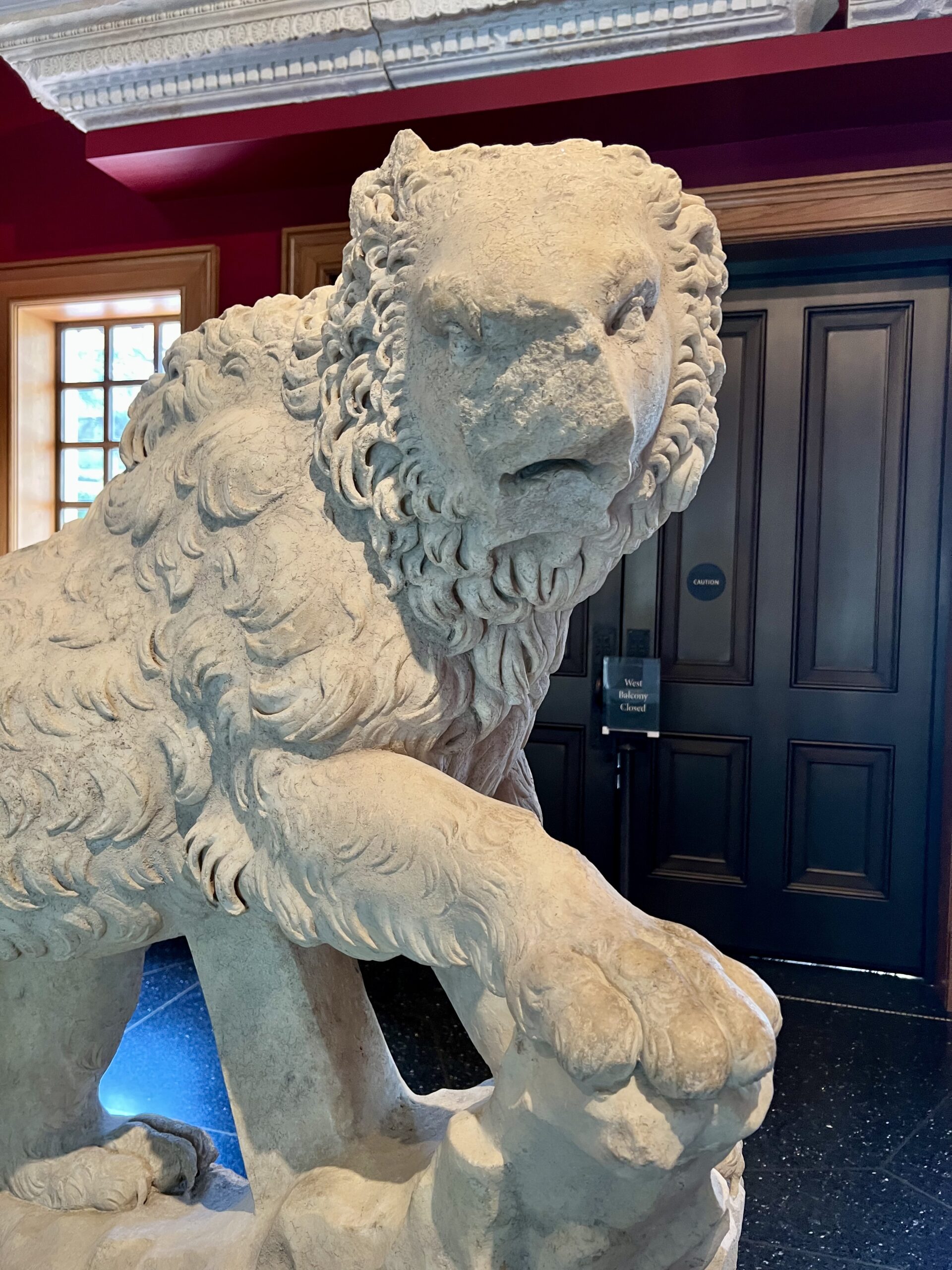
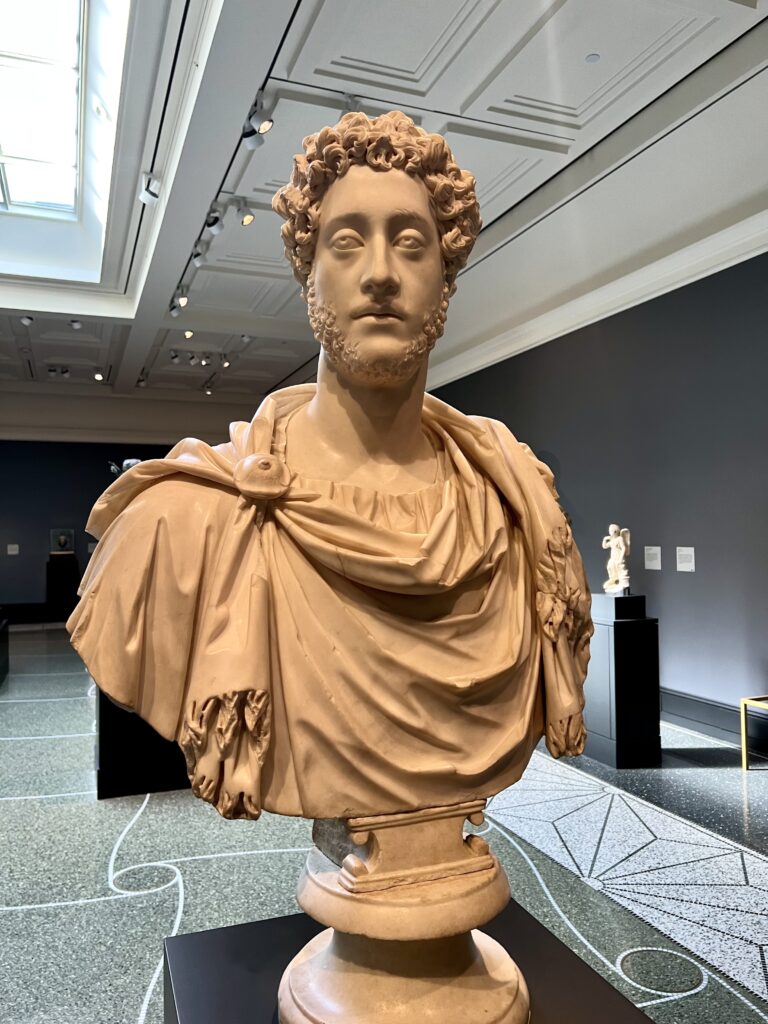
When the Getty Villa acquired the work in 1972, she was missing a head. But a senior curator of the Getty recognized the matching head on view in the Royal-Athena Gallery in New York and acquired it for the museum.
Another gallery on the second floor is dedicated to later Roman sculpture. There, you can inspect the Getty Commodus, a bust of Emperor Commodus.
The Getty acquired the bust in 1992 believing it was a late 16th century copy mimicking the Roman style. But today, most experts think it’s an ancient carving, dating from 180-185 A.D.
The bust is the fifth “type” of Commodus portrait and was likely created when Commodus became sole ruler after the death of his father Marcus Aurelius.
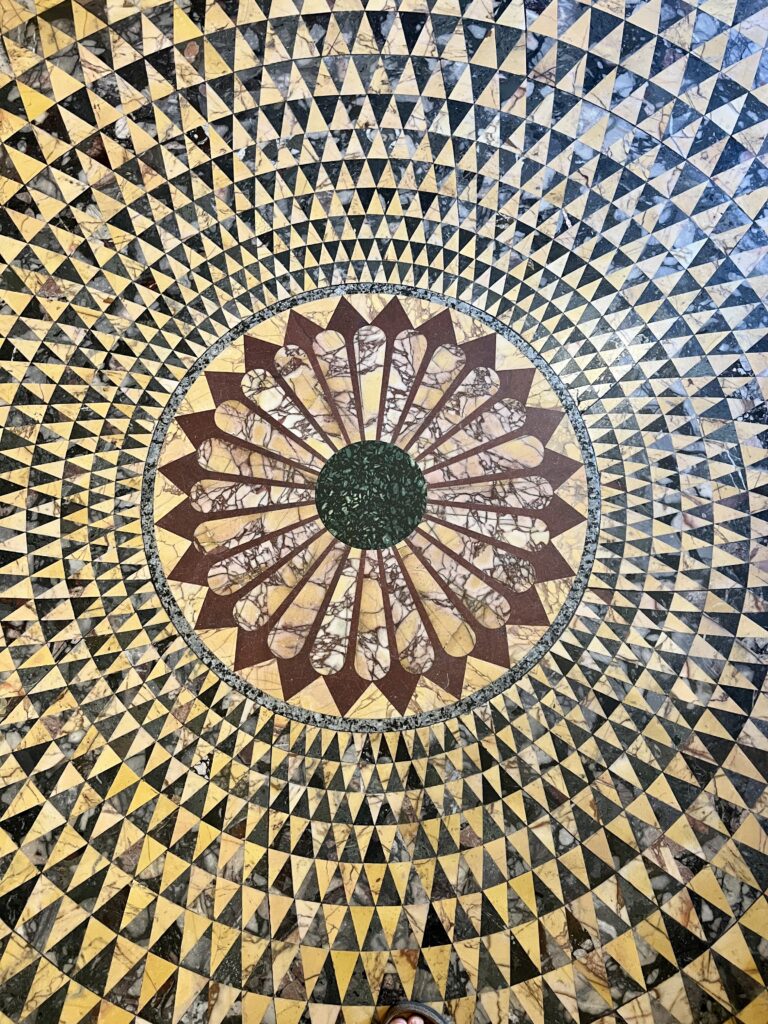
Guide To The Getty Villa: Tips For Visiting
Here are some must know tips for visiting the Getty Villa.
1. Address
17985 E. Pacific Coast Highway, Pacific Palisades CA 90272.
You cannot make a left turn into the villa driveway, so try to approach from the south and keep your eye out for the sign and driveway.
2. Getting To The Getty Villa: Tickets & Parking
Tickets are free, except that you have to pay $20 for parking (or $15 after 3:00 pm). You can’t visit on a walk in basis and no street parking is available. Parking in the neighborhood is only by permit.
You can also take a taxi in. The attendant will direct you to the drop off center.
To visit, you need to make a timed entry reservation online. If you miss your reserved time, you may still be able to enter, if it’s off season or not busy.
Once you’re parked, walk up hill to the museum entrance.
If you are visiting both the Getty Villa and the nearby Getty Center on the same day, you only have to pay for parking once. Stop by the visitor center to get a parking pass for the Getty Center before leaving the Getty Villa.
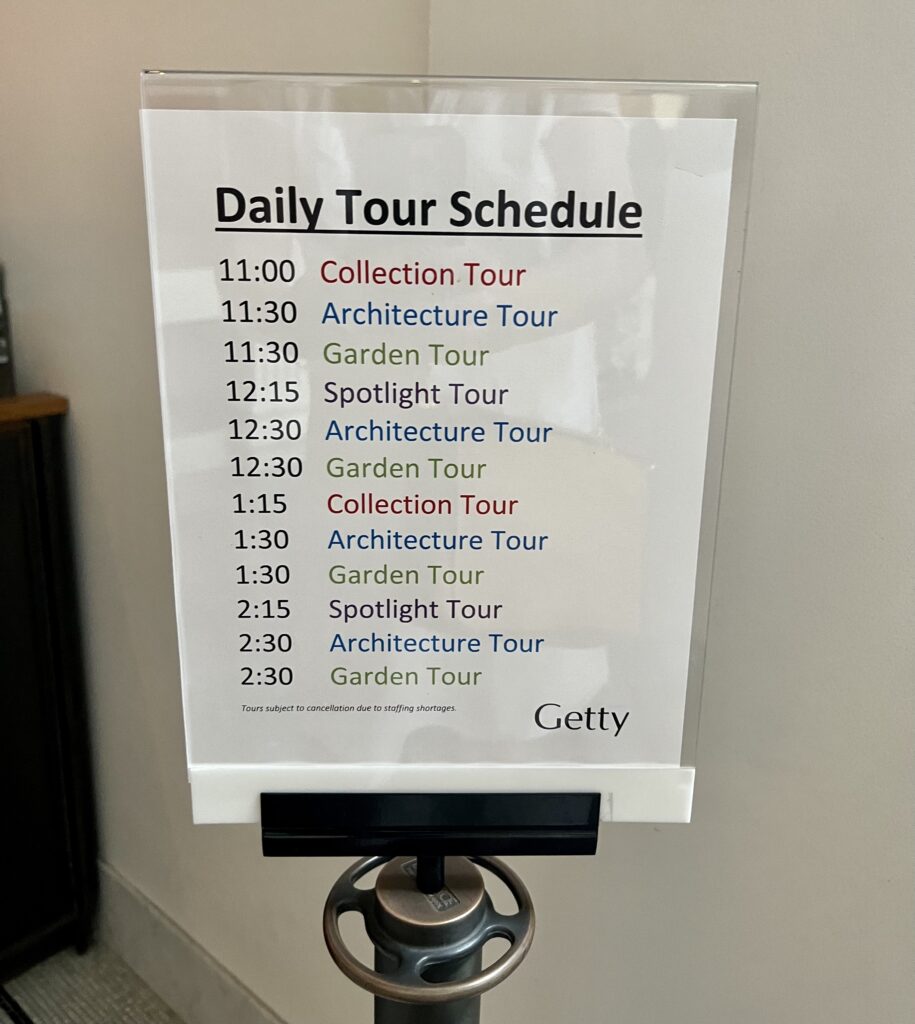
3. Collection Information & Tours
There is plenty of informational signage explaining the exhibits .You can also pick up an audio guide or download the Getty App .
You’ll need to leave your driver’s license or ID to pick up the audio guide. Punch in the number of the artifact you’re admiring to get information on it.
In addition, the Getty Villa offers quite a few themed tours that range from 20 to 45 minutes. The “highlights” tour is a free 50 minute tour of the museum’s greatest hits, which I recommend.
Click here to check out the tours. You need to sign up 15 minutes in advance and tours are limited to 10 per group.
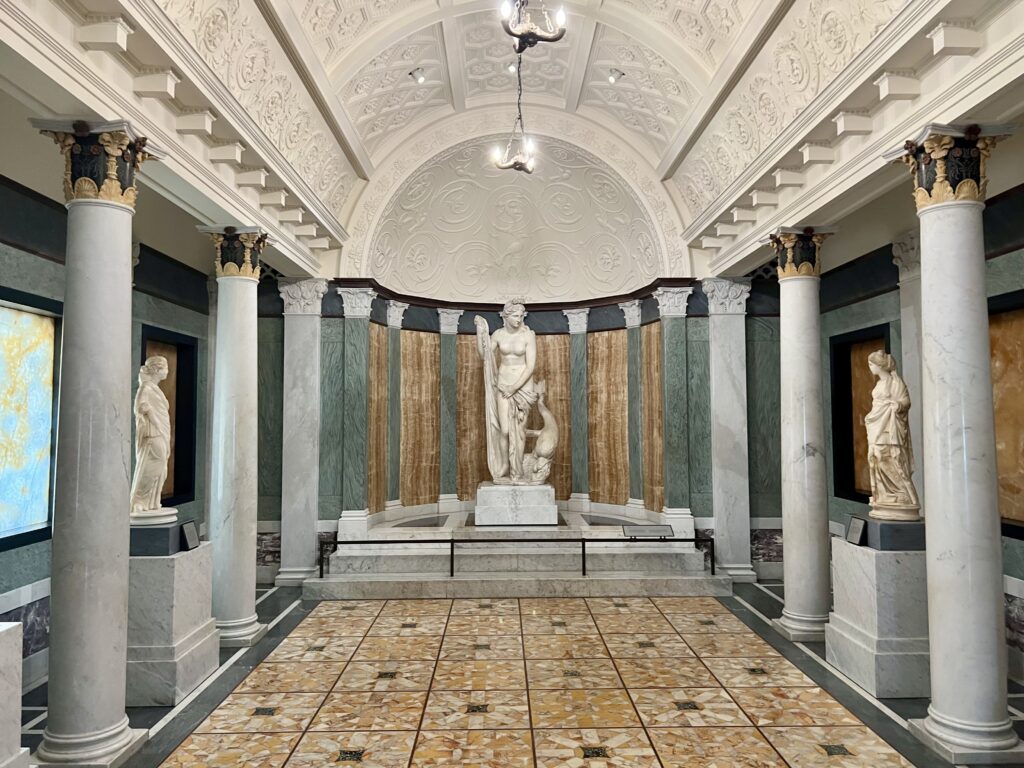
4. Museum Hours
The Getty Villa is open Wednesday through Monday from 10:00 am to 5:00 pm. It’s closed Tuesdays and on January 1, July 4, Thanksgiving, and December 25.
The best time to visit is around 3:00 pm. You’ll get the reduction in parking and have the museum largely to yourself.
5. How Long To Spend At The Getty Villa
The Getty Villa recommends you spend 60-90 minutes visiting. I was there 90 minutes and could definitely have stayed longer. So, if you’re iterested in Greco-Roman history, budget more time.
6. Cafes & Facilities
There’s also an onsite cafe, museum store, and outdoor Roman-style theater. You should hike up the steps of the theater for views down over the villa.
The cafe offers Mediterranean style food with indoor and outdoor seating. Near the cafe is the Espresso Cart for caffeinated beverages and pastries.
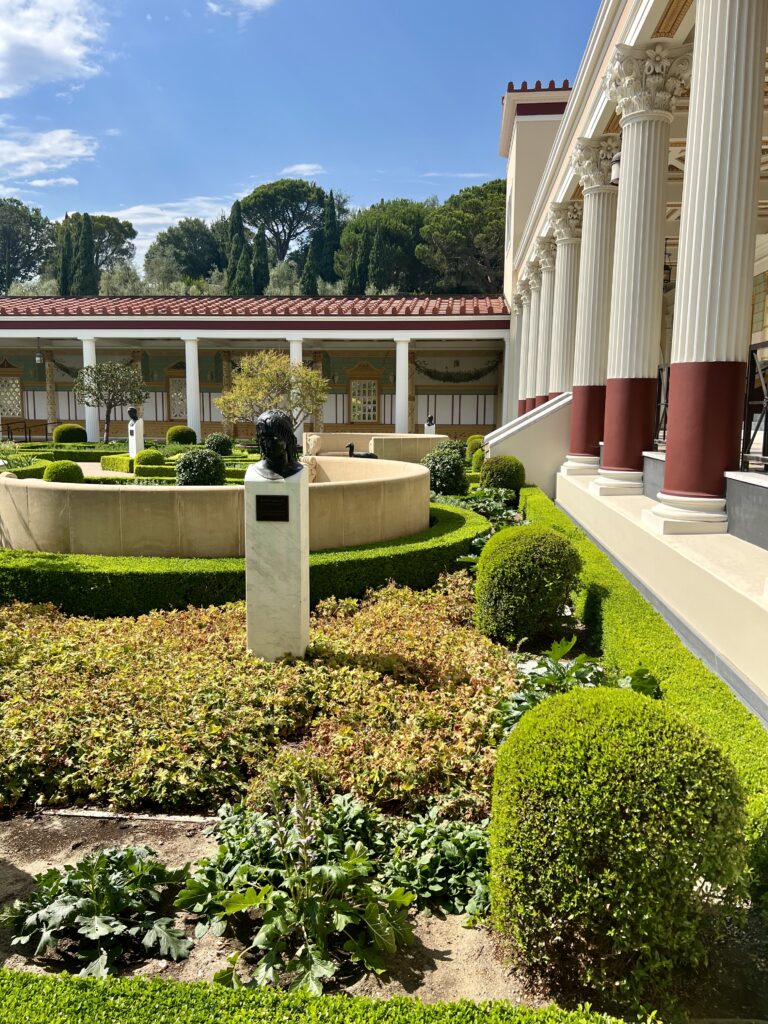
You can also have afternoon tea at the villa. The “Garden Tea” features a menu of sweet and savory flavors inspired by the villa’s Herb Garden. Reservations are required and you can make one on Open Table.
7. Getty Villa Theater
The villa has a Roman-style classical amphitheater near the entrance. The villa hosts concerts and versions of classic Greek and Roman dramas. Click here to check the schedule or purchase tickets.
8. Places To Visit Nearby
You can combine a visit to the Getty Villa with a visit to the Getty Center, Santa Monica, and Venice Beach.
The Getty Center is just 15-25 minutes away (depending on traffic) and makes a nice pairing with the villa. The center is a beautiful modern building designed by world famous architect Richard Meier.
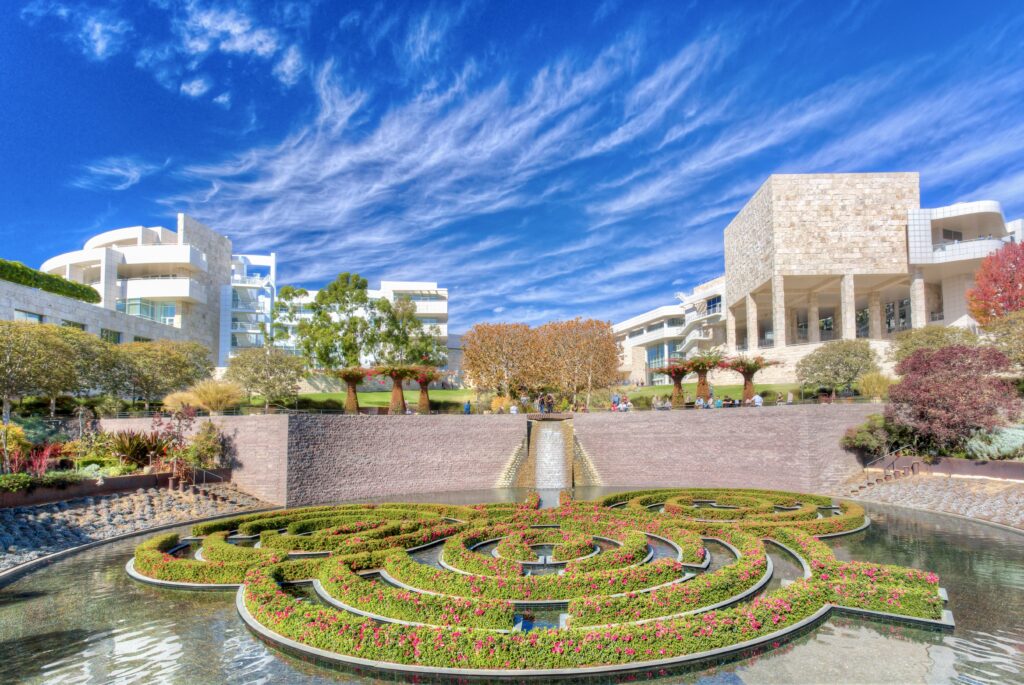
It houses the rest of the Getty Collection. You can see Van Gogh’s Irises and a plethora of old masters from the Renaissance and Baroque periods.
The beach town of Santa Monica is just 15 minutes from the Getty Villa. You can relax on the golden sand beach, sample the pier attractions, and stroll the Third Street Promenade.
Venice Beach is on the south side of Santa Monica. You can walk the iconic boardwalk and enjoy the street performers.
For more information, check out my one day in Santa Monica itinerary.
I hope you’ve enjoyed my guide to visiting the Getty Villa. You may enjoy these other United States travel guides and resources:
- 2 days in Santa Barbara itinerary
- 1 day in La Jolla itinerary
- 2 days in San Diego Itinerary
- 3 day itinerary for Boston
- 1 day itinerary for Denver
- 2 day itinerary for Cleveland Ohio
- 10 day itinerary for New Hampshire
- 10 day itinerary for coastal Maine
- 7-10 day itinerary for Vermont
- 25 most beautiful towns in New England
- 45 amazing destinations in the United States
If you need a guide to the Getty Villa, pin it for later.

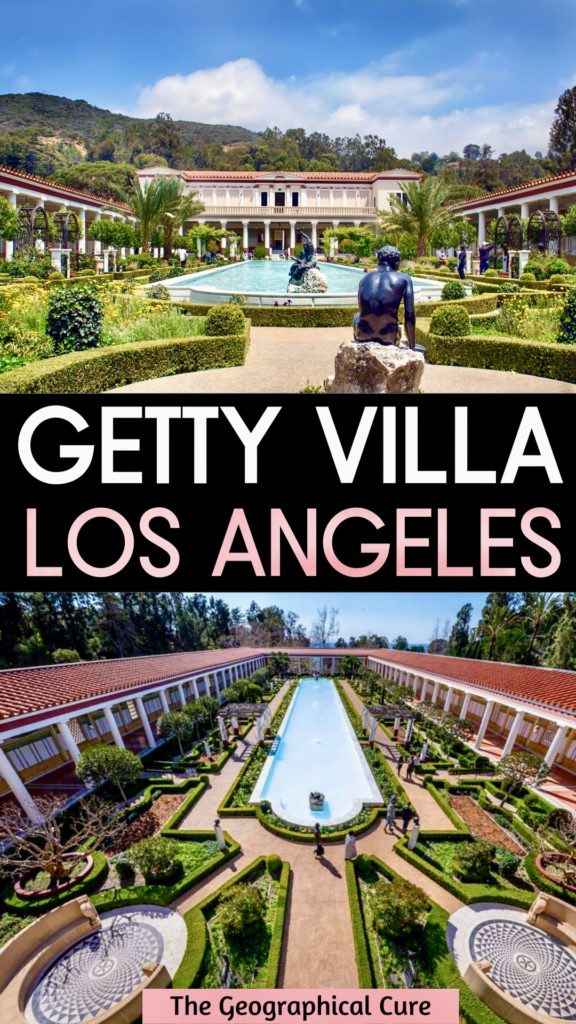
Absolutely amazing place. I was so intrigued. Leslie, your writing is an art in itself.interesting, colorful, informative and well done
Thank you so much!